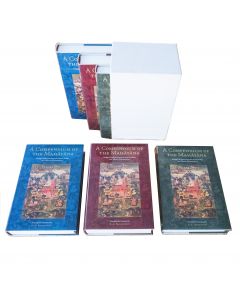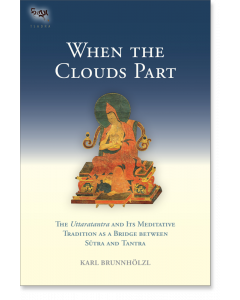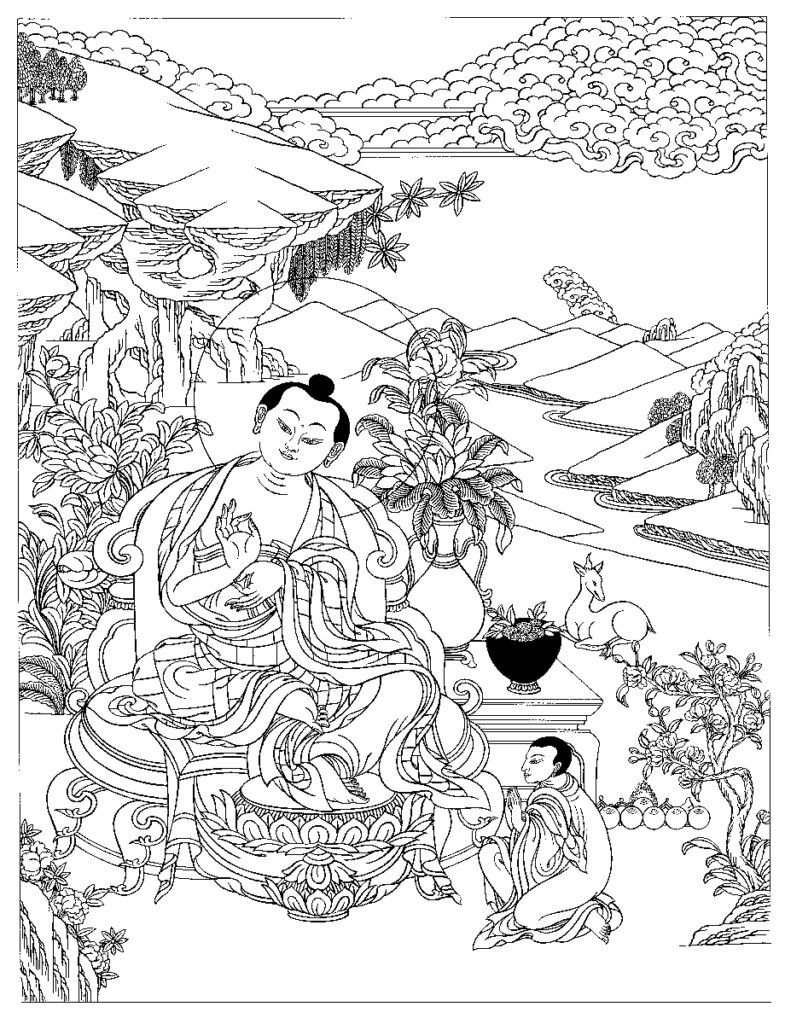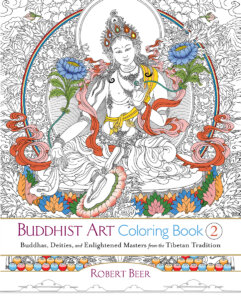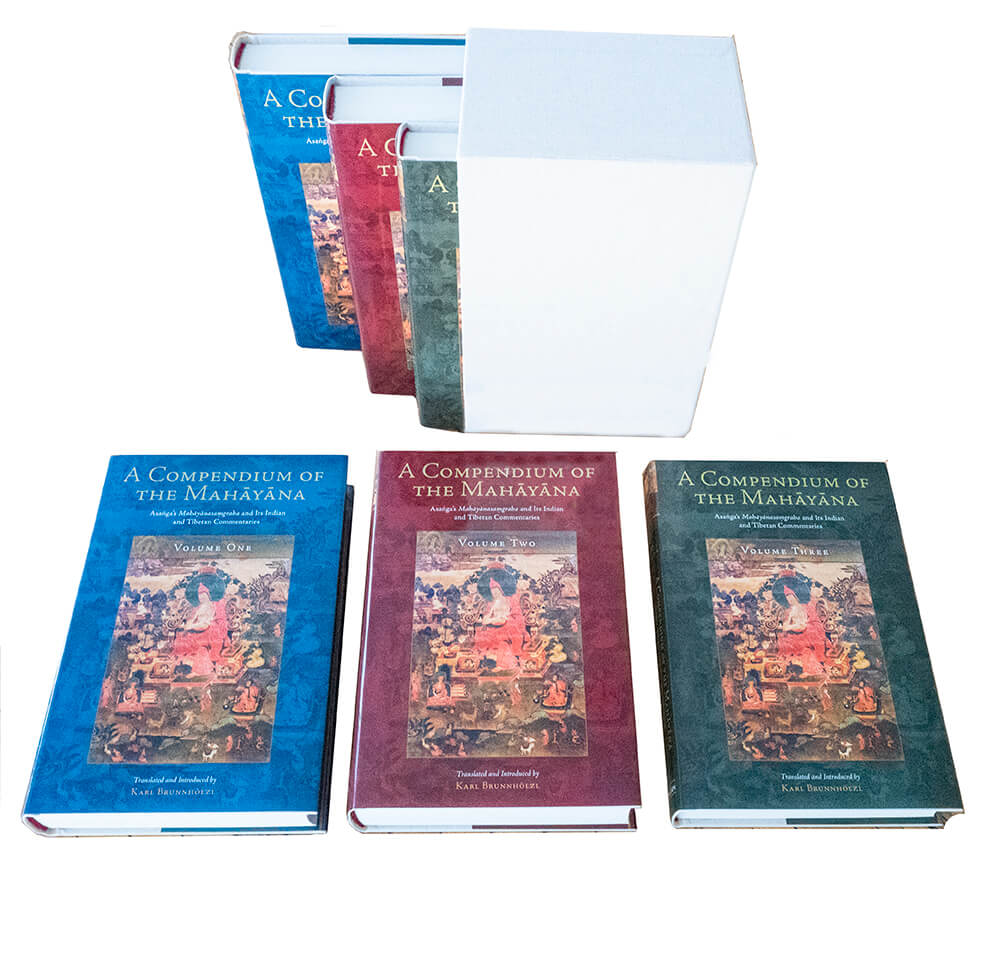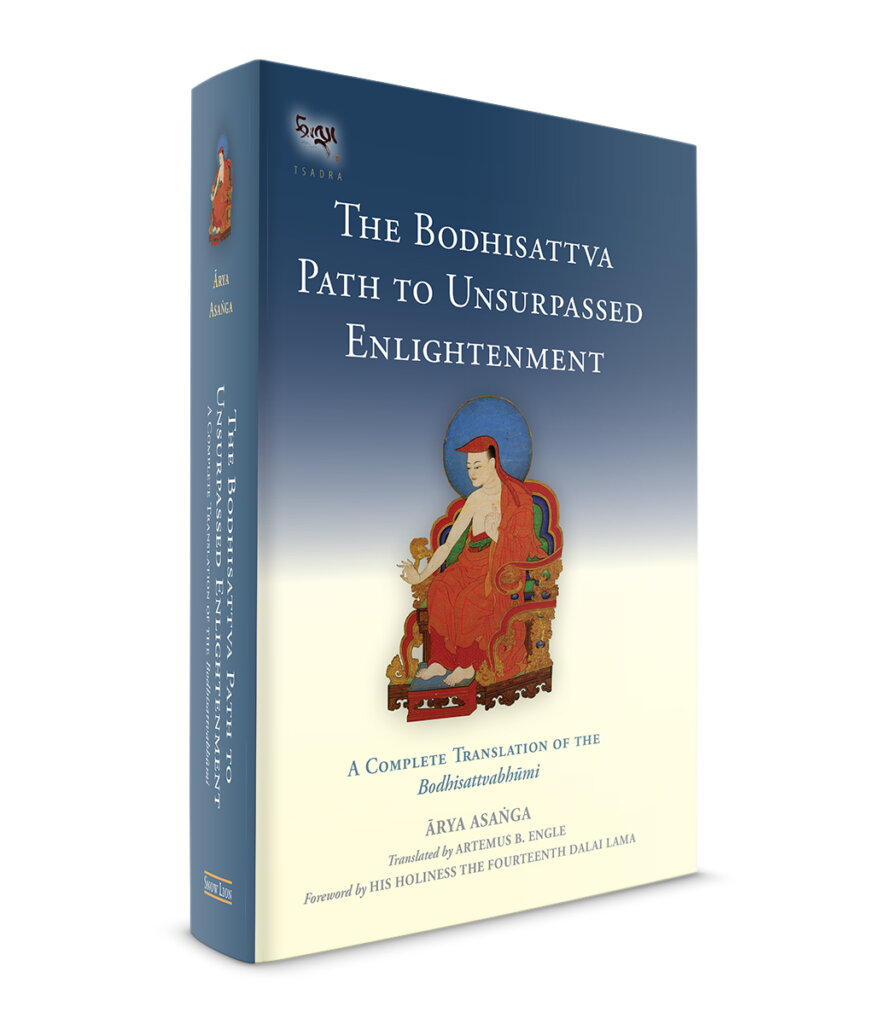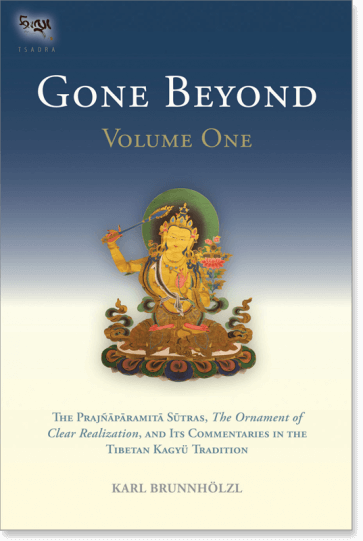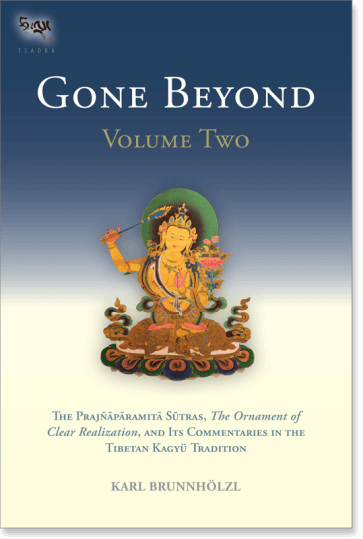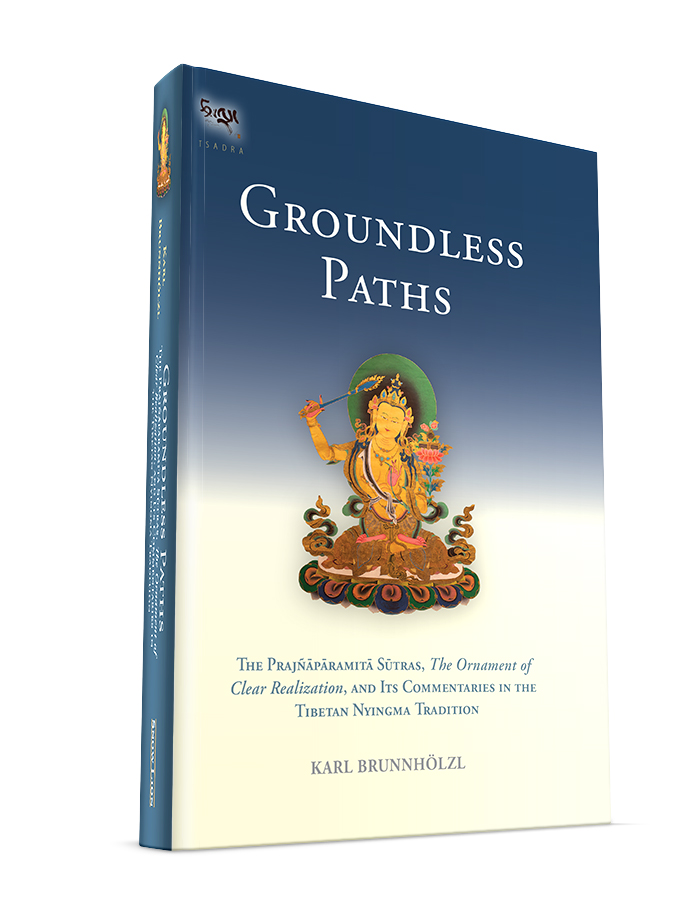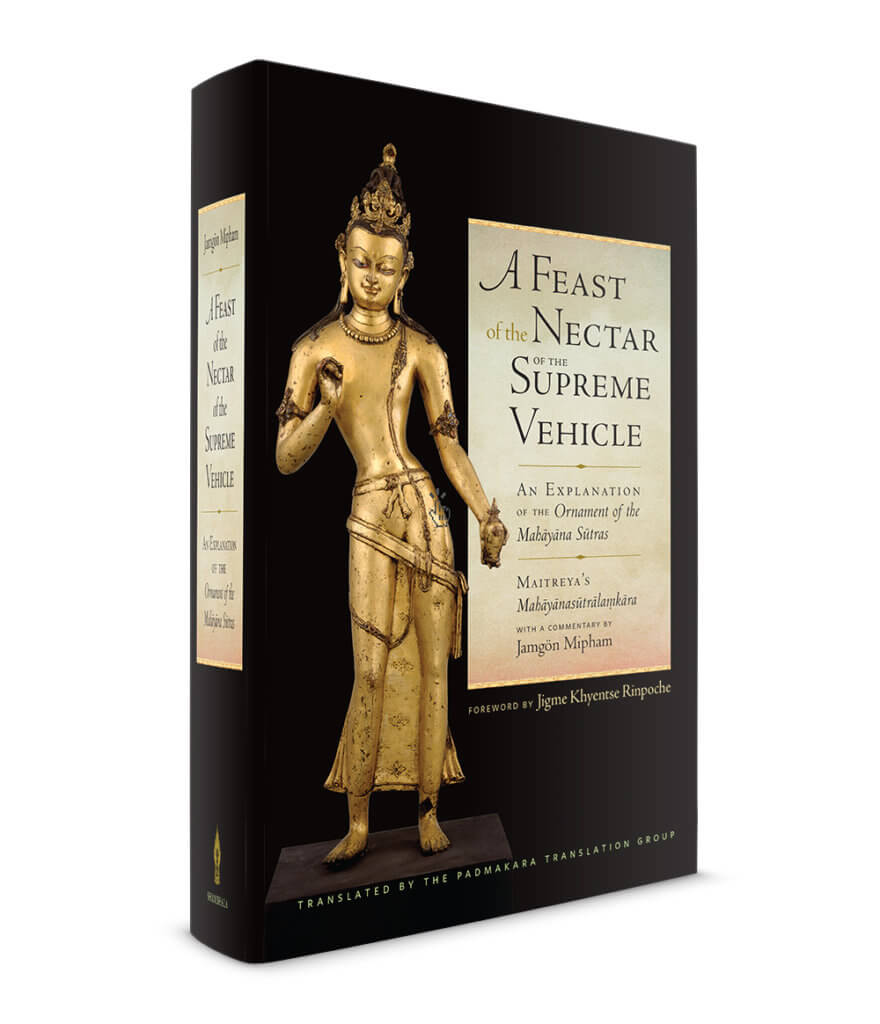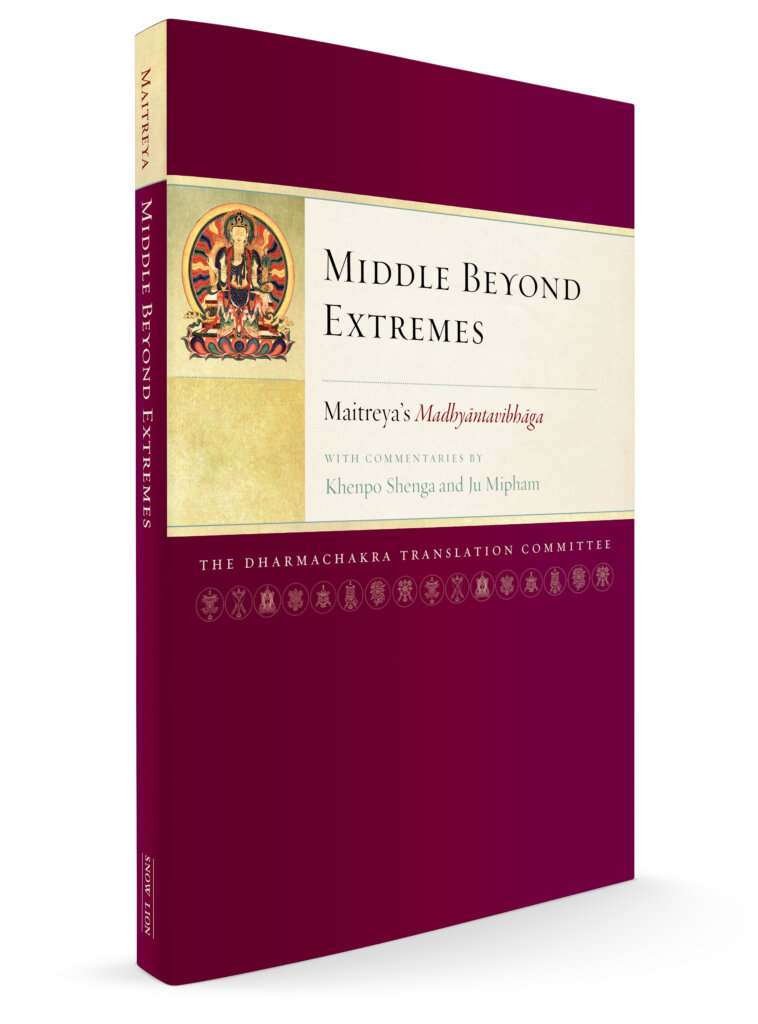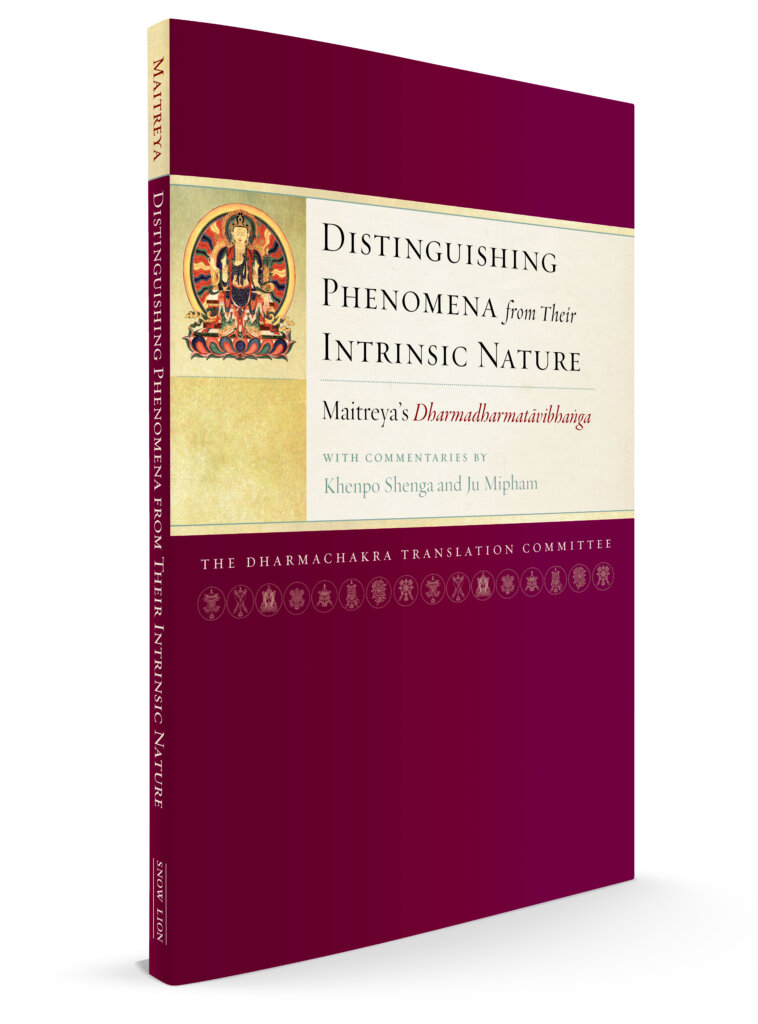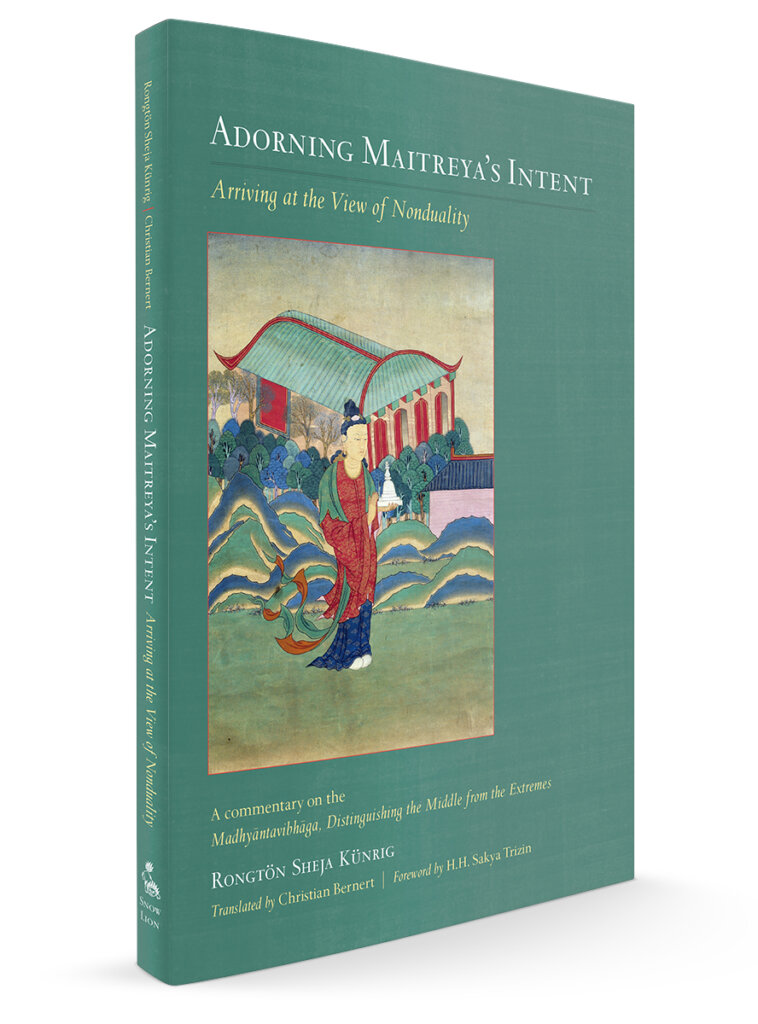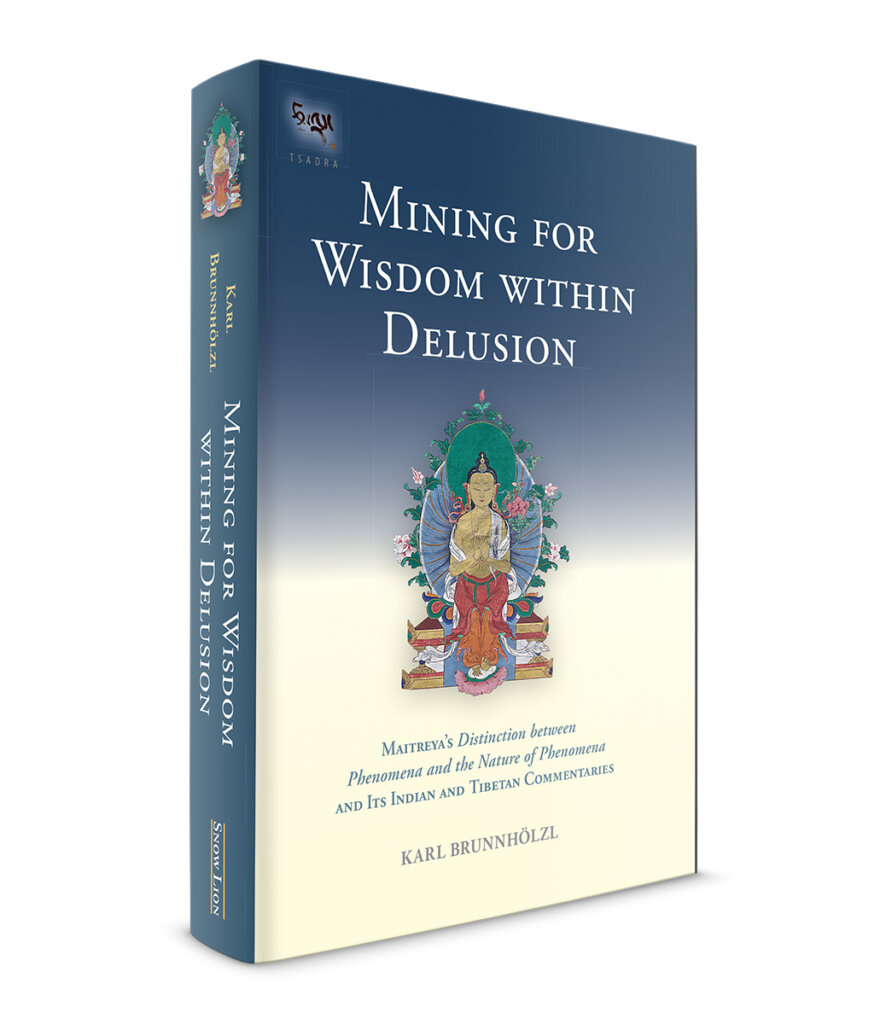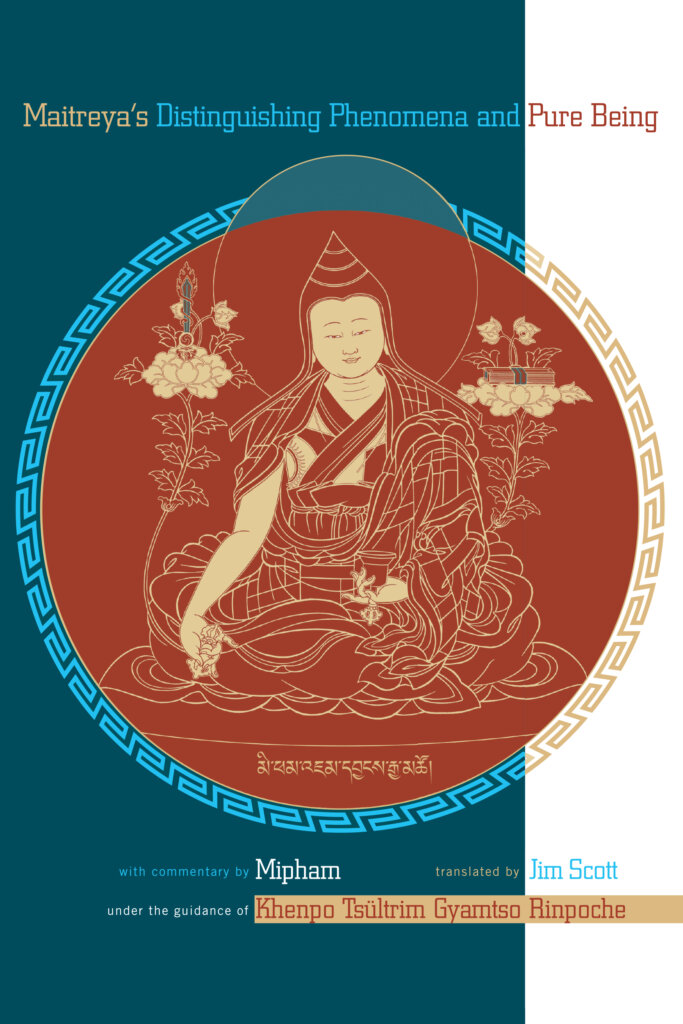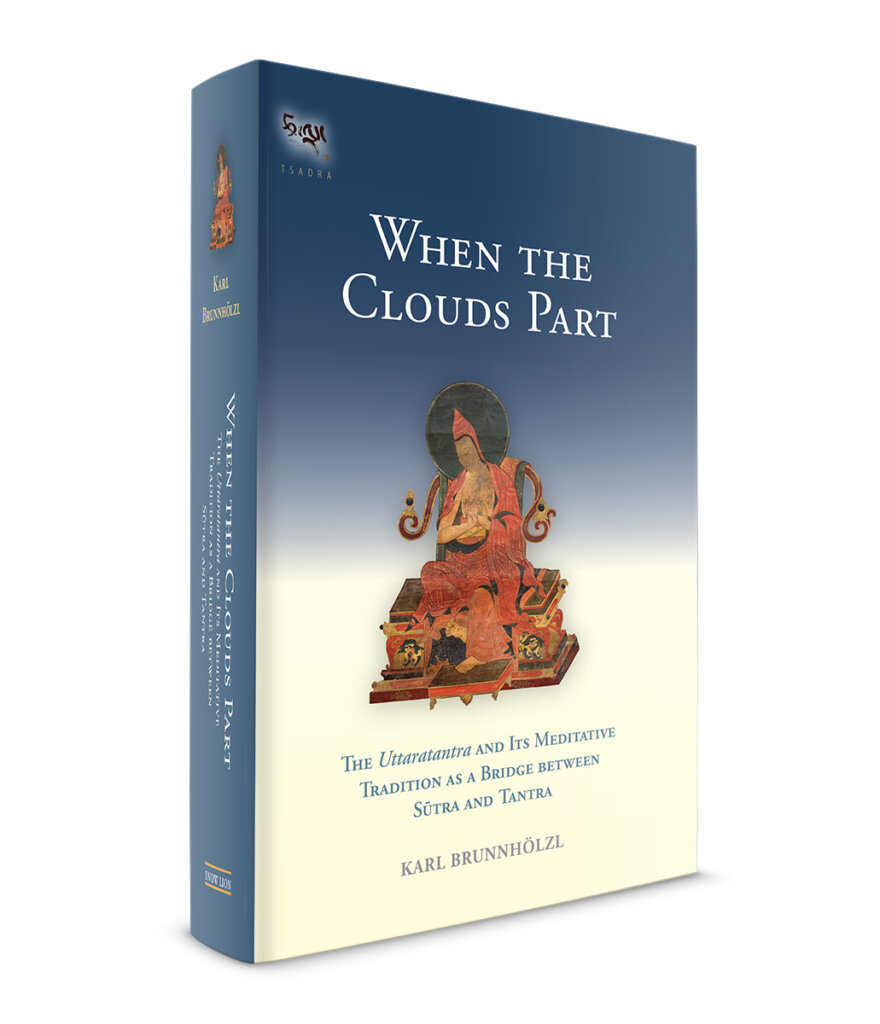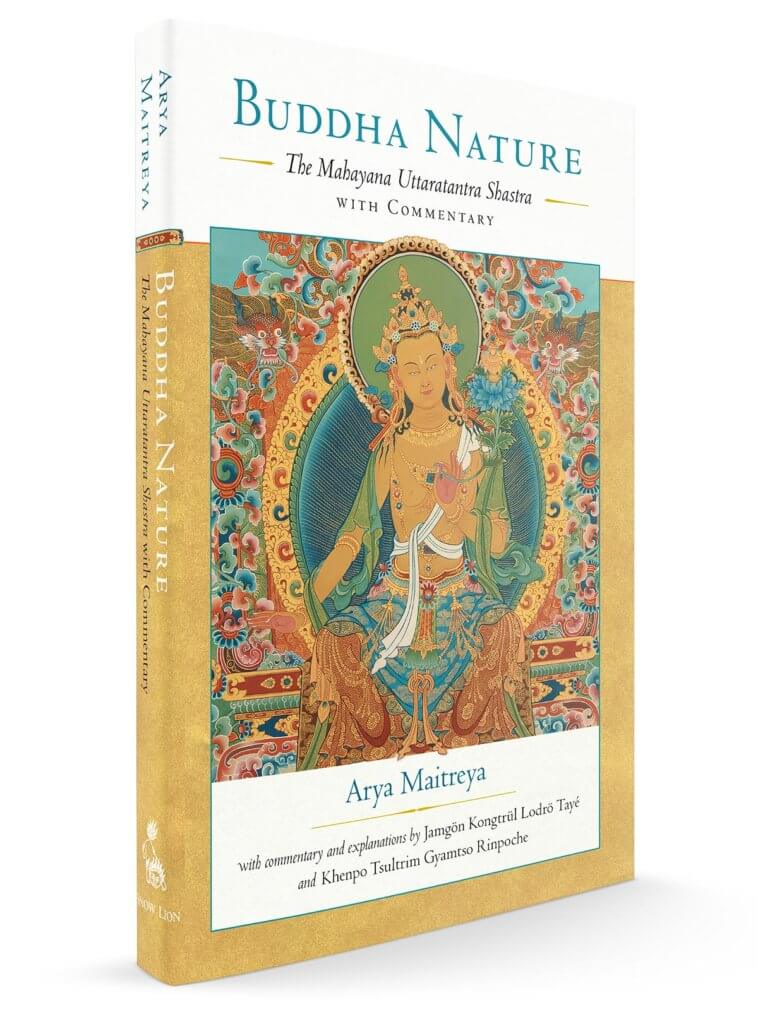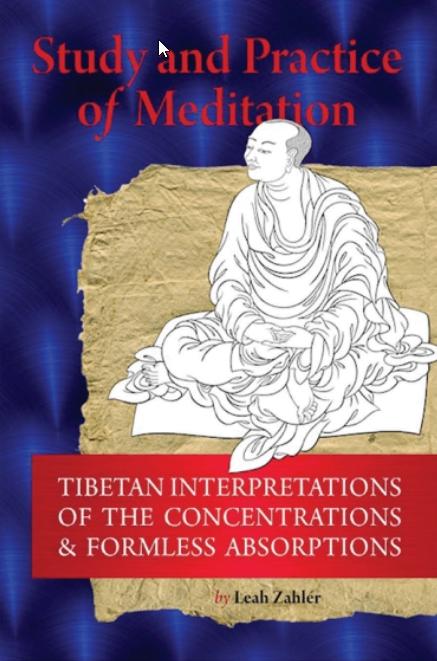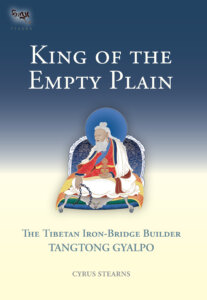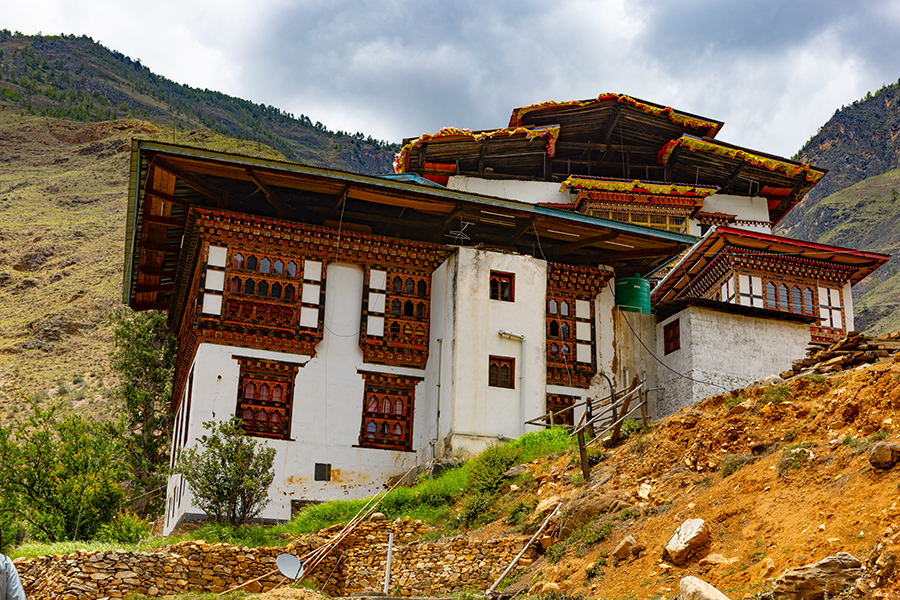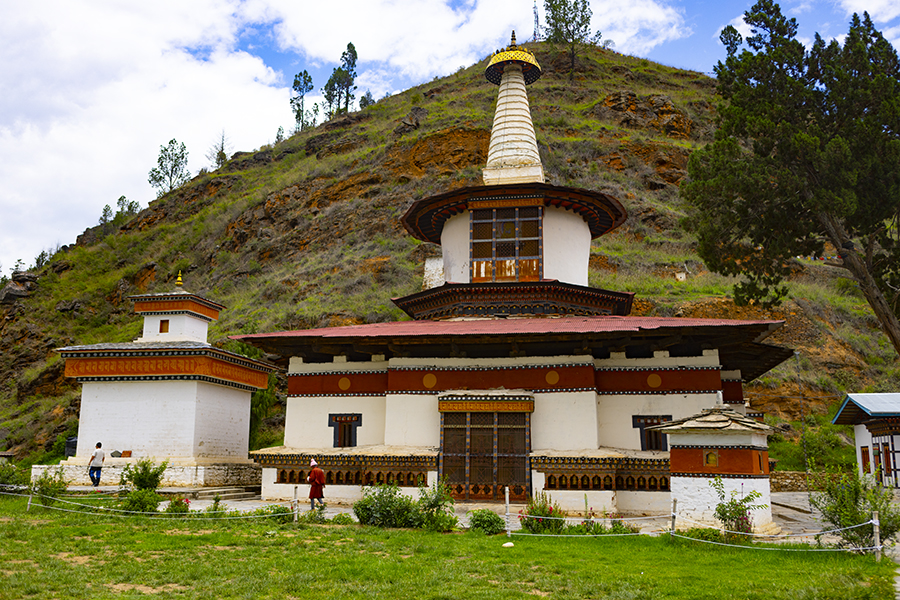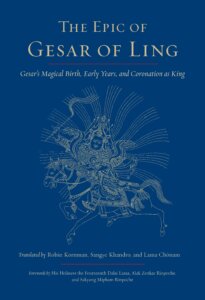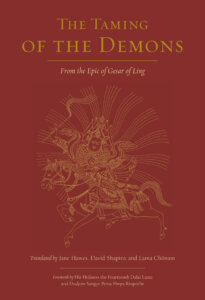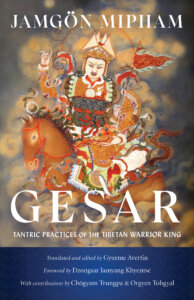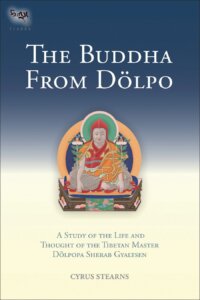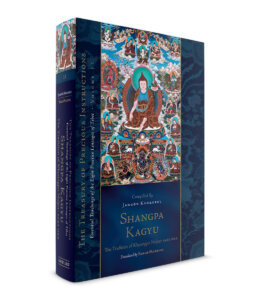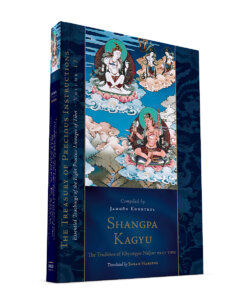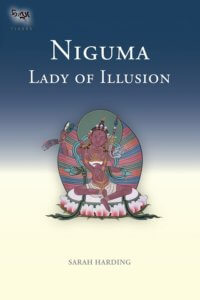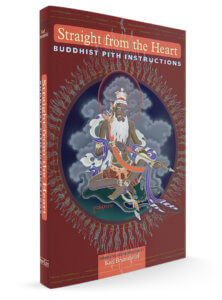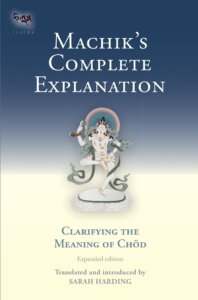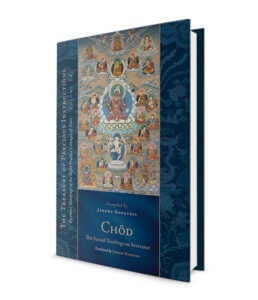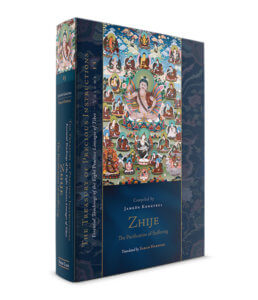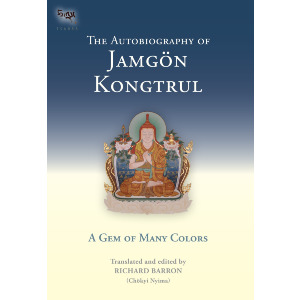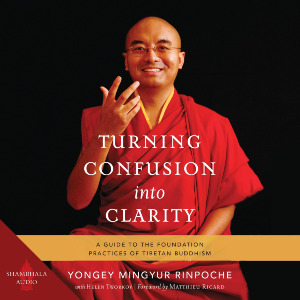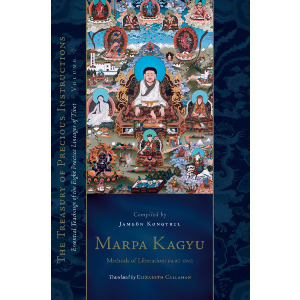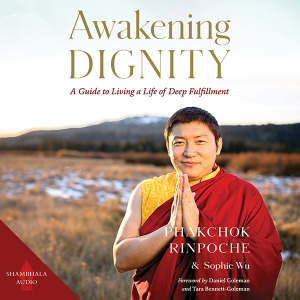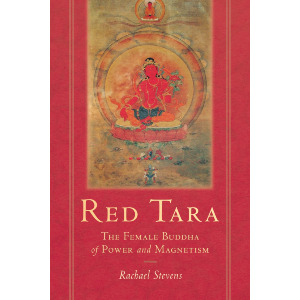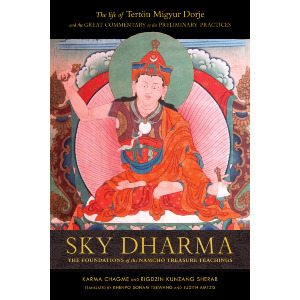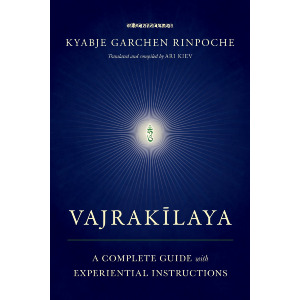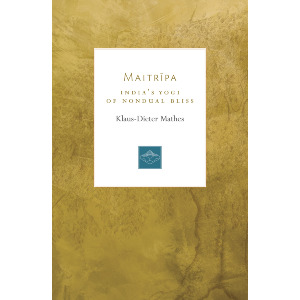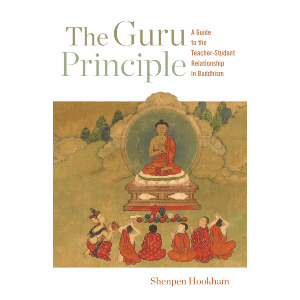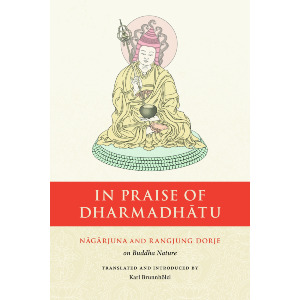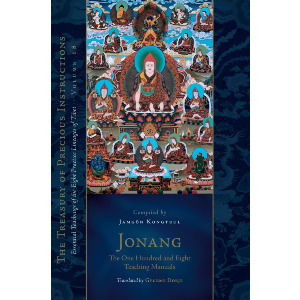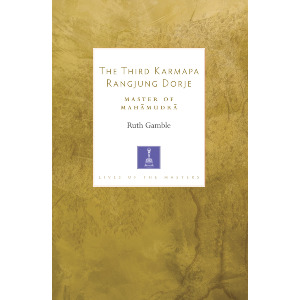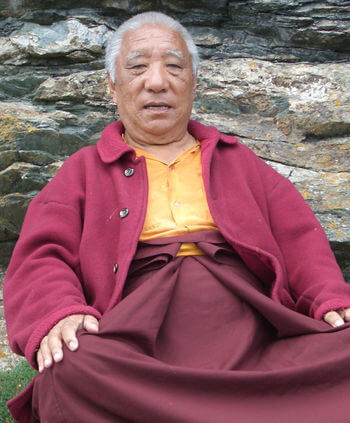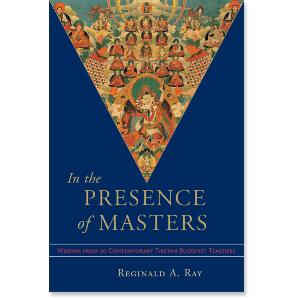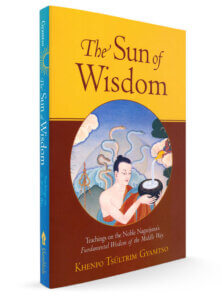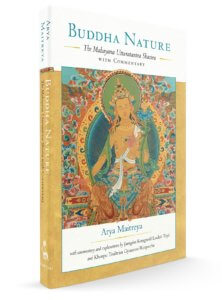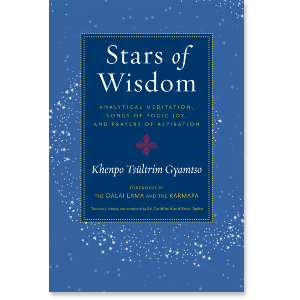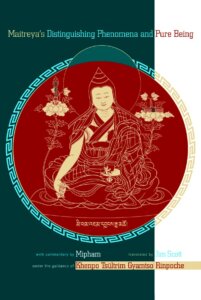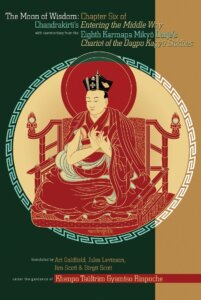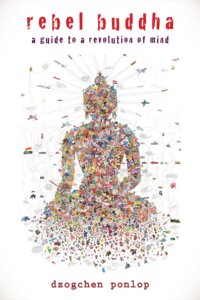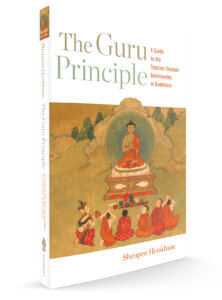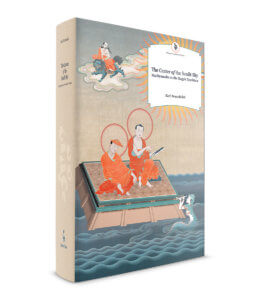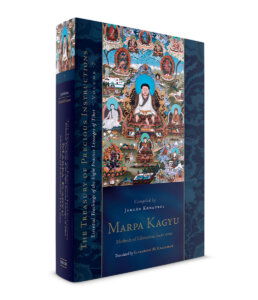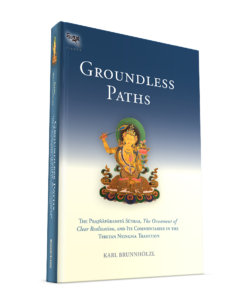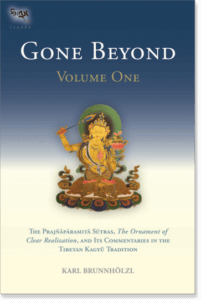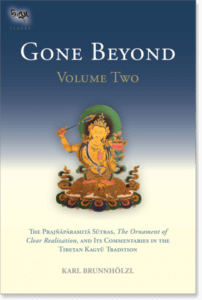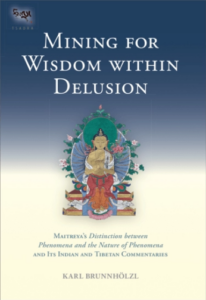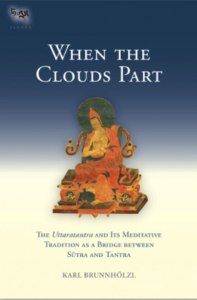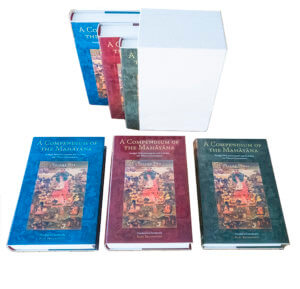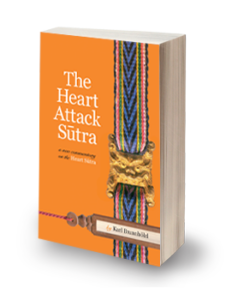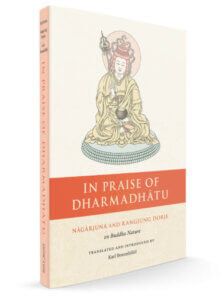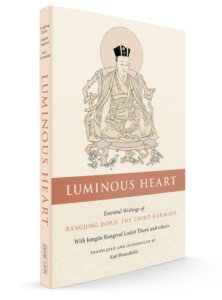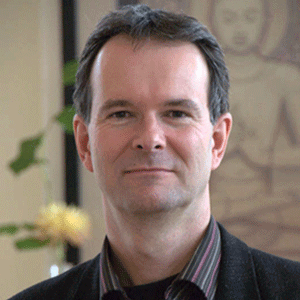

Karl Brunnholzl
Karl Brunnhölzl, MD, was trained as a physician and also studied Tibetology. He received his systematic training in Tibetan language and Buddhist philosophy and practice at the Marpa Institute for Translators, founded by Khenpo Tsultrim Gyamtso Rinpoche. Since 1989 he has been a translator and interpreter from Tibetan and English. He is presently involved with the Nitartha Institute as a teacher and translator.
Karl Brunnholzl
-
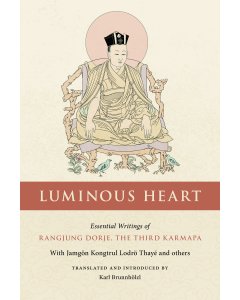 Luminous Heart$32.95- Paperback
Luminous Heart$32.95- PaperbackBy The Third Karmapa
By Jamgon Kongtrul Lodro Taye
Translated by Karl Brunnhölzl -
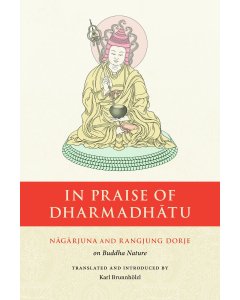 In Praise of Dharmadhatu$29.95- Paperback
In Praise of Dharmadhatu$29.95- PaperbackBy Nagarjuna
Translated by Karl Brunnhölzl
By Rangjung Dorje
GUIDES
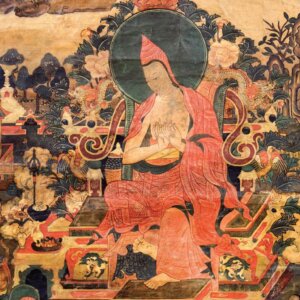
Asanga and Yogacara: A Guide for Readers

Asanga
Asanga, from The Buddhist Art Coloring Book
Asanga, along with his brother Vasabandu, is an inestimably important figure in Mahayana Buddhism, associated with some of the most important works on ethical and moral dimensions of progress on the path, as well as the Yogacara philosophical school. He is particularly revered in Tibet and East Asia.
Asanga is best known for his two "Summary Treatises" and the teachings he received from Maitreya, the Five Maitreya texts.
The following is from Indestructible Truth: The Living Spirituality of Tibetan Buddhism:
Asanga, considered the founder of the Yogachara school, was born into a Buddhist family in the region of Gandhara in northwestern India.3 As a child, he was drawn strongly to meditation but was also schooled in the major divisions of learning then current in India, including writing, debate, mathematics, medicine, and the fine arts. Asanga was a brilliant student and excelled at whatever he tried. At an early age, he took Buddhist ordination within a Hinayana sect, the Mahishasaka, known for the great importance it attached to the practice of meditation.
Asanga trained under several teachers, mastering the Hinayana scriptures and studying Mahayana sutras. When he encountered the Prajnaparamita sutras, however, he found that while he could read their words, he did not really understand their inner meaning or the awakening they described. Asanga felt compelled by these teachings and recognized that the only way he could gain the transcendent wisdom that he longed for would be to enter into a meditation retreat. Having received instruction from his guru, he now went into strict retreat on Mount Kukkutapada. He spent his time meditating and supplicating his personal deity, the future buddha, Maitreya, for guidance, inspiration, and teaching.
Essential Texts by Asanga
Three Volume Slipcase | Ebook
$150.00 - Hardcover
A Compendium of the Mahayana: Asanga’s Mahayanasamgraha and Its Indian and Tibetan Commentaries
By Karl Brunnholzl
Asanga's The Compendium of the Mahayana, or Mahāyānasaṃgraha, is one of the greatest works expounding the Yogacara teachings of Mahayana. It is also an incrediblefeat of translation, done by master translator and scholar Karl Brunnholzl.
The Mahāyānasaṃgraha, published here with its Indian and Tibetan commentaries in three volumes, presents virtually everything anybody might want to know about the Yogācāra School of Mahāyāna Buddhism. It discusses in detail the nature and operation of the eight kinds of consciousness, the often-misunderstood notion of “mind only” (cittamātra), dependent origination, the cultivation of the path and its fruition in terms of the four wisdoms, and the three bodies (kāyas) of a buddha.
Volume 1 presents the translation of the Mahāyānasaṃgraha along with a commentary by Vasubandhu. The introduction gives an overview of the text and its Indian and Tibetan commentaries, and explains in detail two crucial elements of the Yogācāra view: the ālaya-consciousness and the afflicted mind (klistamanas).
Volume 2 presents translations of the commentary by Asvabhāva and an anonymous Indian commentary on the first chapter of the text. These translations are supplemented in the endnotes by excerpts from Tibetan commentaries and related passages in other Indian and Chinese Yogācāra works.
Volume 3 includes appendices with excerpts from other Indian and Chinese Yogācāra texts and supplementary materials on major Yogācāra topics in the Mahāyānasaṃgraha.
Hardcover | Ebook
$59.95 - Hardcover
The Bodhisattva Path to Unsurpassed Enlightenment: A Complete Translation of the Bodhisattvabhumi
By Asanga, translated by Artemus Engle
Ārya Asanga’s Bodhisattvabhūmi, or The Stage of a Bodhisattva, is the Mahāyāna tradition’s most comprehensive manual on the practice and training of bodhisattvas—by the author’s own account, a compilation of the full range of instructions contained in the entire collection of Mahāyāna sutras. A classic work of the Yogācāra school, it has been cherished in Tibet by all the historical Buddhist lineages as a primary source of instruction on bodhisattva ethics, vows, and practices, as well as for its summary of the ultimate goal of the bodhisattva path—supreme enlightenment.
Despite the text’s seminal importance in the Tibetan traditions, it long remained unavailable in English except in fragments. Engle’s translation, made from the Sanskrit original with reference to the Tibetan translation and commentaries, will enable English readers to understand more fully and clearly what it means to be a bodhisattva and practitioner of the Mahāyāna tradition.
A Deep Dive on the Bodhisattvabhumi
Once you have a copy of The Bodhisattva Path to Unsurpassed Enlightenment, a great complement to reading the book is to watch translator and scholar Artemus Engle discuss the work in detail, offering great context. Watch the preview here for a taste, and then jump right into the two talks, free to all.
Overview and Trailer
Part I, 1.5 Hours
Part II, 2 Hours
The Five Maitreya Texts
See also our two interviews on these texts with Karl Brunnholzl and Thomas Doctor of the Dharmachakra Translation Committee.
In Peaceful Heart, Dzigar Kongtrul Rinpoche recounts the story of how Asanga met Maitreya and received the teachings that come down to us as The Five Maitreya texts:
Asanga isolated himself in strict retreat, devoting all his time to practices related to Maitreya. His hope was for Maitreya to appear before him and give him instructions that would lead him to enlightenment. But after six years of diligent practice with no results, Asanga got frustrated and left. On his way home, he met a man who was rubbing a large iron bar with a soft piece of cloth. When Asanga asked what he was doing, the man said he was making a needle. Amazed at the effort people go through to accomplish futile aims, Asanga realized he needed to be more persistent on his path to enlightenment. So he returned to his retreat, determined never to give up. But three years later, when Maitreya still hadn’t appeared, not even in a dream, Asanga again left. This time he met a man who was stroking a massive boulder with a feather dipped in water. The man told him that he wanted to wear away the boulder because it was blocking the sunlight from his house. This gave Asanga renewed determination to keep persevering with his practice. But still Maitreya didn’t come.
Another uneventful and discouraging three years passed. Finally, Asanga left again and began to wander around, feeling hopeless and lost. He saw a crippled dog dragging herself along the road. Her rotting body was infested with maggots that were eating her flesh. Full of pain and aggression, the dog barked viciously at Asanga when he came closer. The sight broke Asanga’s heart. He thought about how to remove the maggots. If he used his hands, the maggots would probably be crushed, so the only way was to use his tongue. Disgusted by the rotting flesh, Asanga closed his eyes and stretched out to lick the maggots out of the dog. But as far as he stretched, he still didn’t feel the maggots. Finally, he felt his tongue touch the ground. He opened his eyes. Instead of the dog, Maitreya stood before him.
"How little compassion you have!" Asanga burst out. "I practiced for twelve years, and you didn’t even appear in my dreams!” Maitreya said, “Since the very first day of your retreat, I’ve been right there with you, but you didn’t have the openness to see me. Your twelve years of practice made your obscurations thinner. Today, your pure compassion for this dog finally made you open enough to see me in person. If you don’t believe me, put me on your shoulder and walk around.” Asanga put Maitreya on his shoulder and walked around at a fair, asking people what they saw on his shoulder. No one saw anything. They just thought he was crazy. Finally, an old woman, who also had developed enough openness to have higher perceptions, asked, “Why are you carrying a rotten dog on your shoulder?"
From then on, Maitreya imparted the teachings which we now know as The Five Maitreya Texts.
The Ornament of Clear Realization: The Abhisamayālaṃkāra
The Abhisamayalamkara summarizes all the topics in the vast body of the Prajnaparamita Sutras. Resembling a zip-file, it comes to life only through its Indian and Tibetan commentaries. Together, these texts not only discuss the "hidden meaning" of the Prajnaparamita Sutras—the paths and bhumis of sravakas, pratyekabuddhas, and bodhisattvas—but also serve as contemplative manuals for the explicit topic of these sutras—emptiness—and how it is to be understood on the progressive levels of realization of bodhisattvas. Thus these texts describe what happens in the mind of a bodhisattva who meditates on emptiness, making it a living experience from the beginner's stage up through buddhahood.
The Ornament of Clear Realization
Karl Brunnholzl discussing the two Gone Beyond volumes on the Kagyu tradition and the Ornament of Clear Realization and Groundless Paths which is the Nyingma take on the same work
Hardcover | Ebook
$54.95 - Hardcover
Gone Beyond (Volume 1)
The Prajnaparamita Sutras, The Ornament of Clear Realization, and Its Commentaries in the Tibetan Kagyu Tradition
By Asanga, Maitreya, the Fifth Shamar Rinpoche, and Karl Brunnholzl
Gone Beyond contains the first in-depth study of the Abhisamayalamkara (the text studied most extensively in higher Tibetan Buddhist education) and its commentaries in the Kagyu School. This study (in two volumes) includes translations of Maitreya's famous text and its commentary by the Fifth Shamarpa Goncho Yenla (the first translation ever of a complete commentary on the Abhisamayalamkara into English), which are supplemented by extensive excerpts from the commentaries by the Third, Seventh, and Eighth Karmapas and others. Thus it closes a long-standing gap in the modern scholarship on the Prajnaparamita Sutras and the literature on paths and bhumis in mahayana Buddhism.
The first volume presents an English translation of the first three chapters of the Abhisamayalamkara and its commentary by the Fifth Shamarpa.
Hardcover | Ebook
$44.95 - Hardcover
Gone Beyond (Volume 2)
The Prajnaparamita Sutras, The Ornament of Clear Realization, and Its Commentaries in the Tibetan Kagyu Tradition
By Asanga, Maitreya, the Fifth Shamar Rinpoche, and Karl Brunnholzl
The second volume presents an English translation of the final five chapters and their commentary by the Fifth Shamarpa.
Hardcover | Ebook
$54.95 - Hardcover
Groundless Paths: The Prajnaparamita Sutras, The Ornament of Clear Realization, and Its Commentaries in the Tibetan Nyingma Tradition
By Asanga, Maitreya, Patrul Rinpoche, Mipham Rinpoche, and Karl Brunnholzl
This study consists mainly of translations of Maitreya's famous text and two commentaries on it by Patrul Rinpoche. These are supplemented by three short texts on the paths and bhumis by the same author, as well as extensive excerpts from commentaries by six other Nyingma masters, including Mipham Rinpoche. Thus this book helps close a long-standing gap in the modern scholarship on the prajñaparamita sutras and the literature on paths and bhumis in mahayana Buddhism.
The Ornament of Mahayana Sutras: The Māhayānasūtrālaṃkāra
Padmakara's Stephen Gethin on the Mahāyānasūtrālaṃkāra
A discussion of the Feast of the Nectar of the Supreme Vehicle and the importance of Mipham Rinpoche's commentary.
Hardcover | Ebook
$54.95 - Hardcover
A Feast of the Nectar of the Supreme Vehicle: An Explanation of the Ornament of the Mahayana Sutras
By Asanga, Mipham Rinpoche. Translated and introduced by the Padmakara Translations Group
A monumental work and Indian Buddhist classic, the Ornament of the Mahāyāna Sūtras (Mahāyānasūtrālamkāra) is a precious resource for students wishing to study in-depth the philosophy and path of Mahāyāna Buddhism. This full translation and commentary outlines the importance of Mahāyāna, the centrality of bodhicitta or the mind of awakening, the path of becoming a bodhisattva, and how one can save beings from suffering through skillful means.
This definitive composition of Mahāyāna teachings was imparted in the fourth century by Maitreya to the famous adept Asanga, one of the most prolific writers of Buddhist treatises in history. Asanga’s work, which is among the famous Five Treatises of Maitreya, has been studied, commented upon, and taught by Buddhists throughout Asia ever since it was composed.
In the early twentieth century, one of Tibet’s greatest scholars and saints, Jamgön Mipham, wrote A Feast of the Nectar of the Supreme Vehicle, which is a detailed explanation of every verse. This commentary has since been used as the primary blueprint for Tibetan Buddhists to illuminate the depth and brilliance of Maitreya’s pith teachings. The Padmakara Translation Group has provided yet another accessible and eloquent translation, ensuring that English-speaking students of Mahāyāna will be able to study this foundational Buddhist text for generations to come.
Distinguishing the Middle from Extremes: The Madhyāntavibhāga
This text explains the vast paths of all three yanas, emphasizing the view of Yogācāra (including the Yogācāra Middle Way) and the distinctive features of the mahāyāna.
Paperback | Ebook
$22.95 - Paperback
Middle Beyond Extremes: Maitreya's Madhyantavibhaga with Commentaries by Khenpo Shenga and Ju Mipham
By Asanga, Khenpo Shenga, Mipham Rinpoche. Translated and introduced by the Padmakara Translations Group
This text employs the principle of the three natures to explain the way things seem to be as well as the way they actually are. It is presented here alongside commentaries by two outstanding masters of Tibet’s nonsectarian Rimé movement, Khenpo Shenga and Ju Mipham.
Distinguishing Phenomena from Their Intrinsic Nature : The Dharmadharmatāvibhāga
This text discusses the difference between samsaric confusion and the liberating power of nonconceptual wisdom-the heart essence of all profound sutras.
Paperback | Ebook
$18.95 - Paperback
Distinguishing Phenomena from Their Intrinsic Nature: Maitreya's Dharmadharmatavibhanga with Commentaries by Khenpo Shenga and Ju Mipham
By Asanga, Maitreya, Khenpo Shenga, Mipham Rinpoche. Translated and introduced by the Dharmachakra Translation Committee
Outlining the difference between appearance and reality, this work shows that the path to awakening involves leaving behind the inaccurate and limiting beliefs we have about ourselves and the world around us and opening ourselves to the limitless potential of our true nature.
By divesting the mind of confusion, the treatise explains, we see things as they actually are. This insight allows for the natural unfolding of compassion and wisdom. This volume includes commentaries by Khenpo Shenga and Ju Mipham, whose discussions illuminate the subtleties of the root text and provide valuable insight into the nature of reality and the process of awakening.
Paperback | Ebook
$24.95 - Paperback
Adorning Maitreya’s Intent: Arriving at the View of Nonduality
By Asanga, Maitreya, Rongtonpa, introduced and translated by Christian Bernert
Here, the Tibetan master Rongtön unpacks this manual and its practices for us in a way that is at once accessible and profound, with actual practical meditative applications. The work explains the vast paths of the three vehicles of Buddhism, emphasizing the view of Yogācāra, and demonstrates the inseparability of experience and emptiness. It offers a detailed presentation of the three natures of reality, an accurate understanding of which provides the antidotes to confusion and suffering. The translator’s introduction presents a clear overview of all the concepts explored in the text, making it easy for the reader to bridge its ideas to actual practice.
Hardcover | Ebook
$39.95 - Hardcover
Mining for Wisdom within Delusion: Maitreya's Distinction between Phenomena and the Nature of Phenomena and Its Indian and Tibetan Commentaries
By Asanga, Maitreya, Vasabandhu, Gö Lotsāwa, The Third Karmapa Rangjung Dorje, . Translated and introduced by Karl Brunnholzl.
Maitreya’s Distinction between Phenomena and the Nature of Phenomena distinguishes the illusory phenomenal world of saṃsāra produced by the confused dualistic mind from the ultimate reality that is mind’s true nature. The transition from the one to the other is the process of “mining for wisdom within delusion.” Maitreya’s text calls this “the fundamental change,” which refers to the vanishing of delusive appearances through practicing the path, thus revealing the underlying changeless nature of these appearances. In this context, the main part of the text consists of the most detailed explanation of nonconceptual wisdom—the primary driving force of the path as well as its ultimate result—in Buddhist literature.
The introduction of the book discusses these two topics (fundamental change and nonconceptual wisdom) at length and shows how they are treated in a number of other Buddhist scriptures. The three translated commentaries, by Vasubandhu, the Third Karmapa, Rangjung Dorje, and Gö Lotsāwa, as well as excerpts from all other available commentaries on Maitreya’s text, put it in the larger context of the Indian Yogācāra School and further clarify its main themes. They also show how this text is not a mere scholarly document, but an essential foundation for practicing both the sūtrayāna and the vajrayāna and thus making what it describes a living experience. The book also discusses the remaining four of the five works of Maitreya, their transmission from India to Tibet, and various views about them in the Tibetan tradition.
Paperback | Ebook
$24.95 - Paperback
Maitreya's Distinguishing Phenomena and Pure Being
By Asanga, Maitreya, and Mipham Rinpoche. Translated by Jim Scott under the guidance of Khenpo Tsultrim Gyamtso.
Maitreya’s Distinction between Phenomena and the Nature of Phenomena distinguishes the illusory phenomenal world of saṃsāra produced by the confused dualistic mind from the ultimate reality that is mind’s true nature. The transition from the one to the other is the process of “mining for wisdom within delusion.” Maitreya’s text calls this “the fundamental change,” which refers to the vanishing of delusive appearances through practicing the path, thus revealing the underlying changeless nature of these appearances. In this context, the main part of the text consists of the most detailed explanation of nonconceptual wisdom—the primary driving force of the path as well as its ultimate result—in Buddhist literature.
The introduction of the book discusses these two topics (fundamental change and nonconceptual wisdom) at length and shows how they are treated in a number of other Buddhist scriptures. The three translated commentaries, by Vasubandhu, the Third Karmapa, Rangjung Dorje, and Gö Lotsāwa, as well as excerpts from all other available commentaries on Maitreya’s text, put it in the larger context of the Indian Yogācāra School and further clarify its main themes. They also show how this text is not a mere scholarly document, but an essential foundation for practicing both the sūtrayāna and the vajrayāna and thus making what it describes a living experience. The book also discusses the remaining four of the five works of Maitreya, their transmission from India to Tibet, and various views about them in the Tibetan tradition.
The Sublime Continuum: The Uttaratantra Śāstra
Also known as the Ratnagotravibhāga Mahāyānottaratantraśāstra, this is a general commentary on buddha nature and represents a bridge between sutra and tantra.
Hardcover | Ebook
$49.95 - Hardcover
When the Clouds Part: The Uttaratantra and Its Meditative Tradition as a Bridge between Sutra and Tantra
By Asanga, Karl Brunnholzl, Mipham Rinpoche, Pema Karpo, Mönlam Tsültrim, Eighth Karmapa, Jamgon Kongtrul and more.
This book discusses a wide range of topics connected with the notion of buddha nature as presented in Indo-Tibetan Buddhism and includes an overview of the sūtra sources of the tathāgatagarbha teachings and the different ways of explaining the meaning of this term. It includes new translations of the Maitreya treatise Mahāyānottaratantra (Ratnagotravibhāga), the primary Indian text on the subject, its Indian commentaries, and two (hitherto untranslated) commentaries from the Tibetan Kagyü tradition. Most important, the translator’s introduction investigates in detail the meditative tradition of using the Mahāyānottaratantra as a basis for Mahāmudrā instructions and the Shentong approach. This is supplemented by translations of a number of short Tibetan meditation manuals from the Kadampa, Kagyü, and Jonang schools that use the Mahāyānottaratantra as a work to contemplate and realize one’s own buddha nature.
Paperback | Ebook
$34.95 - Paperback
Buddha Nature: The Mahayana Uttaratantra Shastra with Commentary
By Maitreya, Asanga, Jamgon Kongtrul, Khenpo Tsultrim Gyamtso, translated by Rosemarie Fuchs
All sentient beings, without exception, have buddha nature—the inherent purity and perfection of the mind, untouched by changing mental states. Thus there is neither any reason for conceit nor self-contempt. This is obscured by veils that are removable and do not touch the inherent purity and perfection of the nature of the mind. The Mahayana Uttaratantra Shastra, one of the “Five Treatises” said to have been dictated to Asanga by the Bodhisattva Maitreya, presents the Buddha’s definitive teachings on how we should understand this ground of enlightenment and clarifies the nature and qualities of buddhahood. This seminal text details with great clarity the view that forms the basis for Vajrayana, and especially Mahamudra, practice.
Paperback | Ebook
$39.95 - Paperback
Study and Practice of Meditation
Tibetan Interpretations of the Concentrations and Formless Absorptions
By Leah Zahler
Study and Practice of Meditation gives a vivid and detailed account of the meditative practices necessary to develop a calm, alert mind that is capable of penetrating the depths of reality. The Buddhist meditative states known as the concentrations and formless absorptions are best known in the West from Theravada scriptures and from Vasubandhu’s Treasury of Manifest Knowledge. Asanga's Summary of Manifest Knowledge (abhidharmasamuccaya, mngon pa kun btus) and his Grounds of Hearers (śrāvakabhūmi, nyan sa)also feature heavily.
In this book the reader is exposed to Tibetan Buddhist views on the mental states attained through meditation as described by three Geluk lamas. The book discusses the ways in which certain meditative states act as bases of the spiritual path as well as the nature of meditative calm and the prerequisites for cultivating and attaining it. In addition to reviewing and translating Tibetan sources, the author considers their major Indian antecedents and draws comparisons with Theravadin presentations.
Additional Resources on Asanga
On Lotsawa House Asanga appears in many translations, generally as a figure in a prayer. 

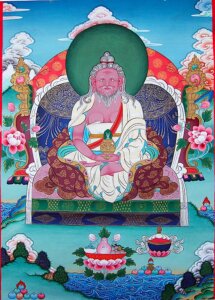
Tangtong Gyalpo: A Guide for Readers
Tangtong Gyalpo: A Guide for Readers
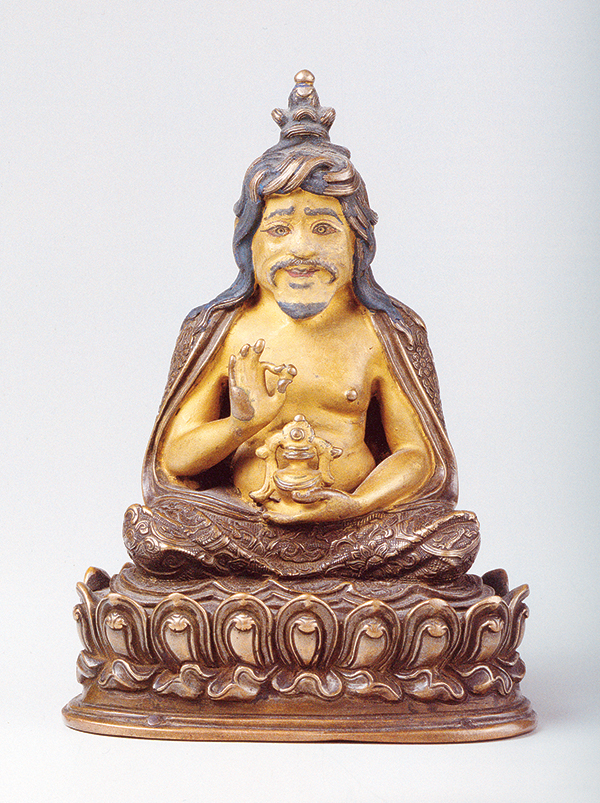
Tangtong Gyalpo (1361-1485 CE), or "The King of the Empty Plain," was a Buddhist mahasiddha, physician, blacksmith, architect, and civil engineer. He's also known by the names Chakzampa, the "Iron Bridge Builder," and Tsondru Zangpo, "Excellent Persistence." Many people believe he was an emanation of both Padmasambhava (known as "Guru Rinpoche" among Tibetan Buddhists) and Dolpopa Sherab Gyaltsen, the foremost master of shentong and a major proponent of the Jonang tradition. Aside from his architectural feats of building 58 iron chain suspension bridges and erecting several large stupas across Tibet and Bhutan, he is known for founding the Iron Chain lineage of the Shangpa Kagyu tradition.
Furthermore, he is known for developing lhamo or Tibetan theater in the 14th century and establishing song and dance troupes to raise money needed to build bridges. Performers would tell stories, recite mantra, and perform song and dance as a means to both teach and subdue demons for the sake of building Tangtong Gyalpo's bridges.
Lastly, Tangtong Gyalpo was known for his ability to eradicate disease. His famous prayer commonly known as "Thangtong Gyalpo's Refuge Prayer" is said to be helpful for averting adverse circumstances and transforming difficulty.
King of the Empty Plain
King of the Empty Plain is one of the most fascinating in-depth portrayals Tibetan master available. Tangtong Gyalpo's incredible lifespan, profound teachings, unprecedented engineering feats, eccentric deeds, and creation of Tibetan opera have earned this fascinating figure a unique status in Tibetan culture. Believed to be the great Indian master Padmasambhava appearing again in the world to benefit living beings, he discovered techniques for achieving longevity that are still held in highest esteem and are frequently taught six hundred years later. His construction of fifty-eight iron suspension bridges, sixty wooden bridges, 118 ferries, 111 stupa monuments, and countless temples and monasteries in Tibet and Bhutan remains an awe-inspiring accomplishment.
This book is a detailed study of the life and legacy of this great master. An extensive introduction discusses Tangtong Gyalpo's Dharma traditions, the question of his amazing longevity, his "crazy" activities manifested to enhance his own realization and to benefit others, and his astonishing engineering and architectural achievements. The book includes a complete translation of the most famous Tibetan biography of Tangtong Gyalpo, as well as the Tibetan text and English translation of a unique early manuscript describing his miraculous death. The text is further enriched with ten color plates and seventy-seven black-and-white illustrations.
Here is a short biographical sketch from King of the Empty Plain by Cyrus Sterns
Countless Buddhist teachers and practitioners have appeared over the centuries in the snowy land of Tibet. None have made a deeper impact on the combined religious, artistic, and technological history of the country than the great adept (mah›siddha, grub chen) Tangtong Gyalpo, “King of the Empty Plain” (Thang stong rgyal po, 1361?−1485). This heroic figure became legendary because of his contributions to the mystical traditions, his exceptionally long life, and his innovative achievements in the fields of art, architecture, and metallurgy. Tangtong’s life and teachings are intertwined with divine madness, visionary revelation, demon exorcism, the quest for immortality, the relationship of human beings with their environment, and the process of ultimate enlightenment. He is famous in Tibet and the Himalayan regions for building many iron suspension bridges and is thus known by the epithet “Iron-Bridge Man” (Lcags zam pa). The great master also constructed many stupas—architectural symbols of enlightened mind—that were strategically located according to geomantic principles in order to control the wild energy of the landscape. Several of his monasteries in Tibet and Bhutan are still famous at the beginning of the twenty-first century.
Tangtong Gyalpo is said to have lived 125 years as a result of his perfection of meditative techniques for achieving longevity. These methods have been passed down as the most efficacious and popular such practices in Tibetan Buddhism. His other systems of meditation, in particular those of Avalokitesvara and Vajravarahı, are still practiced after more than five hundred years. He is known as a mental emanation of Guru Padmasambhava and is believed to have recovered numerous caches of hidden treasure teachings (gter ma) concealed by the Indian master. His nonsectarian activities and teachings have earned him a special position in all the Buddhist traditions of Tibet.
Sterns also writes that Tangtong Gyalpo is represented as a sorcerer-type character in the popular Tibetan epic, Gesar:
Tangtong Gyalpo was also called “Madman of the Empty Valley” (Lung stong smyon pa), one of five names given to him by the dakinis in recognition of his spiritual attainments. This title indicates that he was one of the most important of the “mad adepts” who have been prominent in Tibetan history. He is remembered today as a charismatic figure of dark maroon complexion with long white hair and beard, dressed only in a single cloak, provocative in both appearance and behavior. His reputation as a formidable sorcerer is clearly retained in the popular Gesar legends, where he is identified with the White Old Man, while the tradition of his attainment of immortality is reflected in the opera performances of the Aché Lhamo, which he is said to have created as entertainment for the people while his iron bridges were being built.
Tangtong Gyalpo as the Reincarnation of Dolpopa
Cyrus Stearns also wrote The Buddha from Dolpo: A Study of the Life and Thought of the Tibetan Master Dolpopa Sherab Gyaltsen . Tangtong Gyalpo was considered a rebirth of Dolpopa and unsurprisingly features in this book as well.
Tangtong Gyalpo and the Shangpa Kagyu Tradition
Shangpa Kagyu is a Tibetan school founded by the 11th century master, Khyungpo Naljor after receiving teachings and revelations from two dakinis: Niguma and Sukhasiddhi. Tangtong Gyalpo is among the masters who upheld the tradition along with others such as Jetsün Taranatha and Jamgon Kongtrul Lodro Taye, who compiled a collection of teachings from the Eight Great Practice Lineages of Tibet including Shangpa Kagyu. This 18 volume collection is called The Treasury of Precious Instructions. Shangpa Kagyu makes up volumes 11 and 12.
Specifically, Volume 12 (ie., Part 2 of the Shangpa Kagyu volumes) includes several essential writings from Tangtong Gyalpo including Collection of Essentials: Vital Words of Instruction on the Six Dharma of Niguma, Dakini of Timeless Awareness and a number of auxiliary practices and teachings from Niguma.
Shangpa Kagyu: The Tradition of Khyungpo Naljor, Part One
By Jamgon Kongtrul Lodro Taye
Translated by Sarah Harding
About this volume:
Volume 11 of the series, Shangpa Kagyu, is the first of two volumes that present a selection of teachings and practices from the Shangpa practice lineage of Tibetan Buddhism. This tradition was established in Tibet by the eleventh-century yogi Khyungpo Naljor, who had received profound esoteric teachings from many great Indian masters, especially the two yoginīs Niguma and Sukhasiddhi, as well as Maitrīpa, Rāhula, and Vajrāsana.
Shangpa Kagyu: The Tradition of Khyungpo Naljor, Part Two
By Jamgon Kongtrul Lodro Taye
Translated by Sarah Harding
About this volume:
This is the second of two volumes that present teachings and practices from the Shangpa Kagyu practice lineage of Tibetan Buddhism. This tradition derives from two Indian yoginīs, the dākinīs Niguma and Sukhasiddhi, and their disciple, the eleventh-century Tibetan yogi Khyungpo Naljor Tsultrim Gönpo of the Shang region of Tibet.
Related Books from Shangpa Kagyu
About this book:
Providing a rare glimpse of feminine Buddhist history, Niguma, Lady of Illusion brings to the forefront the life and teachings of a mysterious eleventh-century Kashmiri woman who became the source of a major Tibetan Buddhist practice lineage. The circumstances of her life and extraordinary qualities ascribed to her are analyzed in the greater context of spiritual biography and Buddhist doctrine. More than a historical presentation, Niguma's story raises the question of women as real spiritual leaders versus male images of feminine principle and other related contemporary issues. This volume includes the thirteen works that have been attributed to Niguma in the Tibetan Buddhist canon.
Songs and Prayers by Tangtong Gyalpo
Tangtong Gyalpo wrote a number of prayers, poems, and songs of realization throughout his life. The most well-known prayer is called Drubchen tangtong gyalpö tukdam chi nang sangwé kyab dro or, The Outer, Inner, and Secret Refuge Practice of the Mahāsiddha Thangtong Gyalpo. According to the colophon
"This prayer carries the blessing of Avalokiteśvara, who transmitted it to the Lord of Dharma Ka Ngapa and told him to give it to Gelong Tsöndru Zangpo (Thangtong Gyalpo), saying that if he taught it to the people of this world, it would dispel all sickness, negative influences and obstacles right now, and then also grant protection from the lower realms."
This prayer is still used today by Tibetan Buddhist practitioners of various lineages.

The Outer, Inner, and Secret Refuge Practice of the Mahāsiddha Tangtong Gyalpo
མ་ནམ་མཁའ་དང་མཉམ་པའི་སེམས་ཅན་ཐམས་ཅད་བླ་མ་སངས་རྒྱས་རིན་པོ་ཆེ་ལ་སྐྱབས་སུ་མཆིའོ། །
ma namkha dang nyampé semchen tamché lama sangye rinpoche la kyab su chi o
All mother sentient beings as infinite as space take refuge in the guru, the precious buddha.
སངས་རྒྱས་ཆོས་དང་དགེ་འདུན་རྣམས་ལ་སྐྱབས་སུ་མཆིའོ། །
sangye chö dang gendün nam la kyab su chi o
In the Buddha, Dharma and Saṅgha, we take refuge.
བླ་མ་ཡི་དམ་མཁའ་འགྲོའི་ཚོགས་ལ་སྐྱབས་སུ་མཆིའོ། །
lama yidam khandrö tsok la kyab su chi o
In the assembly of gurus, yidam deities and ḍākinīs, we take refuge.
རང་སེམས་སྟོང་གསལ་ཆོས་ཀྱི་སྐུ་ལ་སྐྱབས་སུ་མཆིའོ། །
rangsem tongsal chö kyi ku la kyab su chi o
In the dharmakāya, the inseparable emptiness and clarity of our own minds, we take refuge.
[See Lotsawa House for more translations like this]
Songs for Tangtong Gyalpo
In Karl Brunnhölzl's collection, Straight From the Heart: Buddhist Pith instructions, there are numerous poems for and dedicated to Tangtong Gyalpo including the following prayer of devotion to Tangtong Gyalpo by Khamba Deleg Bal:
O father, qualified and precious guru,
Man of iron bridges whose name is so well-renowned,
Nirmanakaya of all the Buddhas,
Amazing one named by the dakinis,There are many gurus whose faces I have seen,
But uncontrived devotion was never before born in me.
Now that I have met you, a guru who is a Buddha,
I supplicate you to give me the pith instructions.
About this Book:
Straight from the Heart brings together an inspiring collection of Buddhist teachings, songs of realization, meditation instructions, and enlightened poetry—all chosen for their power to speak directly to the student. Drawn from Indian Mahayana and Vajrayana Buddhism as well as from all four schools of Tibetan Buddhism, some will impress with their beautiful poetry and powerful imagery, others with their profound power of instruction.
Tangtong Gyalpo and the Chöd Tradition
Chöd is a traditional Tibetan Buddhist and Bon practice that's based on the teachings of the Prajñapāramitā or Perfection of Wisdom Sutras. Often translated as "cutting through," chöd emphasizes realizing emptiness—the ultimate nature of reality.
Tangtong Gyalpo was a chöd master known for practicing chöd before initiating construction projects for the sake of warding off inner and outer obstacles.
In King of the Empty Plain, Cyrus Sterns writes:
The most closely guarded esoteric teachings of Tangtong Gyalpo concern the practice of Chöd, or Severance, about which he never wrote. During the course of his studies and travels, Tangtong studied all the systems of Chöd in Tibet. From Lhadongpa Sönam Chokpa, he received the transmission of the Chöd practices taught by Padmasambhava and passed down in the Northern Treasure tradition of the Nyingma School, which were based on the treasures of Gökyi Demtruchen (1337−1408). However, it was a vison of Vajrāvārahī appearing to Tangtong as Machik Labdrön (eleventh–twelfth centuries) in the Kashmiri cemetery of Rāmeśvara that was to be most significant. Machik Labdrön was the mother of the most influential Chöd system in Tibet, and the visionary teachings she transmitted to Tangtong form the basis of Tangtong’s Oral Transmission (Thang stong snyan brgyud), also known as the Oral Transmission of Machik’s Secret Behavior (Ma gcig gsang spyod snyan brgyud), which has been passed down without interruption to the present day. Tangtong specifically practiced Chöd to bring the local spirits under his control long before beginning his first construction projects.
Related Books from the Tibetan Buddhist Tradition
Related Articles
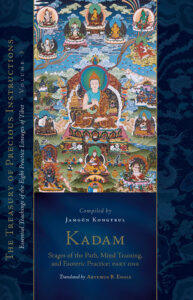
Bodhisattva’s Jewel Garland: An Excerpt from Kadam, Part One
Bodhisattva's Jewel Garland: A Root Text of Mahāyāna Instruction from the Precious Kadam Scripture Excerpted from Kadam: Stages of the Path, Mind Training, and Esoteric Practice, Part One...
Tibetan Buddhist Books in 2023: A Review
See our other Year in Review Guides: Zen and Chan | Tibetan Buddhism | More in Buddhism Yoga | Kids Books...
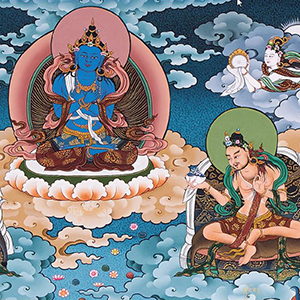
Tibetan Masters of the 10th-11th Centuries
See Also: Profiles of early Indian Mahayana figures | Tibetan Masters of the 8th Century | Tibetan Masters of the 10th-11th Centuries...
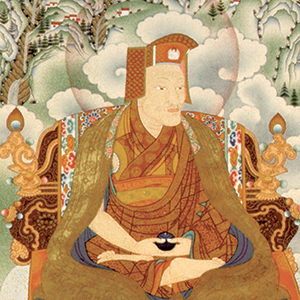
Gampopa: A Guide for Readers Related Reader Guides:...
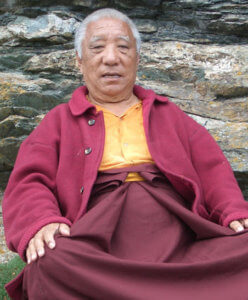
Khenpo Tsültrim Gyamtso: A Guide for Readers
Khenpo Tsültrim Gyamtso: A Guide for Readers
Khenpo Tsültrim Gyamtso Rinpoche is a Tibetan Buddhist teacher in the Kagyu tradition. Born to a nomad family in Ngangchen, Kham (the eastern region of Tibet), Khenpo Tsültrim began his training under Lama Zopa Tarchin at an early age. He later attended intensive retreats and continued his training under the lineage holder of the Karma Kagyu, the 16th Gyalwa Karmapa. Since fleeing Tibet in the late 1950's under Chinese rule, Khenpo Tsültrim continued his studies in Northern India and later settled in Bhutan. He is the root teacher of prominent Buddhist teachers such as Dzogchen Ponlop Rinpoche and Lama Shenpen Hookham and therefore plays a significant role in their respective organizations—Nalandabodhi and the Awakened Heart Sangha.
Khenpo Tsültrim teaches widely in the West and is known emphasizing the union of practice and study. He is therefore himself a prolific scholar as well as an accomplished practitioner. Below you'll find longer biography from In the Presence of Masters, a selection of books written by Khenpo Tsültrim, as well as texts written and translated by his students under his guidance.
Short Biography
From In the Presence of Masters: Wisdom from 30 Contemporary Tibetan Buddhist Teachers
Edited by Reginald A. Ray
Khenpo Rinpoche was born to a nomad family in East Tibet in 1934. Drawn to spiritual practice, he left home at an early age to train with his root guru, the yogin Lama Zopa Tarchin. After completing this early training, Tsultrim Gyamtso embraced the life of a yogi-ascetic, wandering throughout East and Central Tibet, undertaking solitary retreats in caves to realize directly the teachings he had received. He often lived in charnel grounds in order to practice and master chöd, a skillful means to cut ego clinging, develop compassion, and realize deeper levels of emptiness. Subsequently he took up retreat in the caves above Tsurphu, the seat of the Karmapas, where he received instructions on the six yogas of Naropa, the Hevajra Tantra, and other profound teachings from Dilyak Tenzin Drupon Rinpoche and other masters. Escaping to India at the time of the Chinese invasion, he was able to continue his training, studying the sutras, the tantras, and all four schools of Tibetan Buddhism He became renowned for his skill in logic and debate, and received a khenpo degree from H. H. the sixteenth Karmapa, and the equivalent geshe lharampa degree from H. H. the fourteenth Dalai Lama. In 1975 Khenpo Tsultrim established the Thegchen Shedra in Athens, Greece, and for the next ten years taught throughout Europe. Since 1985 he has traveled widely, completing annual world tours in response to invitations from Europe, the United States, Canada, South America, Southeast Asia, Africa, and Australia. In 1986 he founded the Marpa Institute for Translators, in Boudhanath, Nepal, to offer intensive courses in language and scripture. Khenpo Rinpoche continued to supervise this annual event when it moved to Pullahari Monastery above Boudhanath. While Khenpo Tsultrim Gyamtso unites prodigious intellect with great compassion, he also embodies the training and temperament of a true yogi. In fact, Rinpoche is often compared to the great yogi Milarepa, whom he resembles in both substance and style.
Books By Khenpo Tsültrim Gyamtso
Teachings on Buddha Nature and the Two Truths
Khenpo Tsultrim wrote a commentary for each of the most widely known texts in the Tibetan Buddhist tradition: Nagarjuna's Mūlamadhyamakakārikā, or Root Verses of the Middle Way, and Maitreya's Mahāyānuttaratantra Śāstra, or the Treatise on the Sublime Continuum.
In addition, Khenpo Tsultrim's Stars of Wisdom explains how to access the nature of reality pointed out in philosophical texts such as those above through analytical meditation, songs of experience, and other practical Tibetan Buddhist tools.
The Sun of Wisdom: Teachings on the Noble Nagarjuna's Fundamental Wisdom of the Middle Way
The Fundamental Wisdom of the Middle Way was written in the second century and is one of the most important works of Nagarjuna, the pioneering commentator on the Buddha's teachings on the Madhyamika or Middle Way view. The subtle analyses presented in this treatise were closely studied and commented upon by many realized masters from the Indo-Tibetan Buddhist tradition.
Using Nagarjuna's root text and the great modern master Ju Mipham's commentary as a framework, Khenpo Tsültrim Gyamtso explains the most important verse from each chapter in the text in a style that illuminates for modern students both the meaning of these profound teachings and how to put them into practice in a way that benefits both oneself and others.
Buddha Nature: The Mahayana Uttaratantra Shastra with Commentary
By Maitreya & Asanga
With Commentary By Jamgon Kongtrul Lodro Taye & Khenpo Tsultrim Gyamtso
Translated by Rosemarie Fuchs
All sentient beings, without exception, have buddha nature—the inherent purity and perfection of the mind, untouched by changing mental states. Thus there is neither any reason for conceit nor self-contempt. This is obscured by veils that are removable and do not touch the inherent purity and perfection of the nature of the mind. The Mahayana Uttaratantra Shastra, one of the “Five Treatises” said to have been dictated to Asanga by the Bodhisattva Maitreya, presents the Buddha’s definitive teachings on how we should understand this ground of enlightenment and clarifies the nature and qualities of buddhahood. This seminal text details with great clarity the view that forms the basis for Vajrayana, and especially Mahamudra, practice.
$27.95 - Paperback
By: H.H. the Fourteenth Dalai Lama & Ari Goldfield & Khenpo Tsultrim Gyamtso & Rose Taylor Goldfield
Stars of Wisdom: Analytical Meditation, Songs of Yogic Joy, and Prayers of Aspiration
By Khenpo Tsultrim Gyamtso
Translated byAri Goldfield & Rose Taylor Goldfield
By Khenpo Tsultrim Gyamtso
Tibetan Buddhist master Khenpo Tsültrim Gyamtso is known for his joyful songs of realization and his spontaneous and skillful teaching style. In this book he explains how to gain clarity, peace, and wisdom through step-by-step analysis and meditation on the true nature of reality. He also introduces readers to the joy and profundity of yogic song, and reveals the power of aspiration prayers to inspire, transform, and brighten our hearts.
Translations Under the Guidance of Khenpo Tsültrim Gyamtso
As a scholar-practitioner himself, many of Khenpo Tsultrim's students are active scholars, translators, practitioners, and authorized teachers. Below are a couple examples of translations and scholarship done under the guidance of Khenpo Tsultrim.
Maitreya's Distinguishing Phenomena and Pure Being
Translated by Jim Scott
By Jamgon Mipham
Distinguishing Phenomena and Pure Being was composed by Maitreya during the golden age of Indian Buddhism. Mipham's commentary supports Maitreya's text in a detailed analysis of how ordinary, confused consciousness can be transformed into wisdom. Easy-to-follow instructions guide the reader through the profound meditation that gradually brings about this transformation. This important and comprehensive work belongs on the bookshelf of any serious Buddhist practitioner—and indeed of anyone interested in realizing their full potential as a human being.
By Chandrakirti & The Eighth Karmapa Mikyo Dorje
Translated by Ari Goldfield, Jules B. Levinson, Jim Scott, & Birgit Scott
Under the Guidance of Khenpo Tsultrim Gyamtso
Nagarjuna, in his seminal text, The Fundamental Wisdom of the Middle Way, summarized the vast teachings of the Buddha and used logical reasoning to prove the validity of his words. Entering the Middle Way is Chandrakirti's explanation of Nagarjuna's work. Its sixth chapter, which comprises the majority of the text, has four main sections: an explanation of how in genuine reality phenomena do not truly arise; a refutation of the Mind-Only School's assertion that mind truly exists; a refutation of the true existence of the personal self; and an explanation of the sixteen emptinesses taught by"the Buddha in the Transcendent Wisdom Sutras. The Moon of Wisdom is thus a book that explains the Buddha's ultimate teachings, how to gain confidence in them, and how to put them into practice in one's"own life to the great benefit of oneself and others.
Additional Books by Khenpo Tsultrim's Students and Lineage
As mentioned above, Khenpo Tsultrim has had many prolific students over the years owing to his focus on cultivating practitioners that are both engaged in traditional practice and scholarship. Prominent students include Dzogchen Ponlop Rinpoche, and Lama Shenpen Hookham. In addition to these two, there are a number of translators and senior students from Khenpo Tsultrim's lineage with a remarkable practice and scholastic history including Karl Brunnhölzl and Elizabeth Callahan. These examples of teachers and senior students are just a few illustrations of the flavor and style of teaching and practice presented by Khenpo Tsultrim Gyamtso.
Dzogchen Ponlop Rinpoche
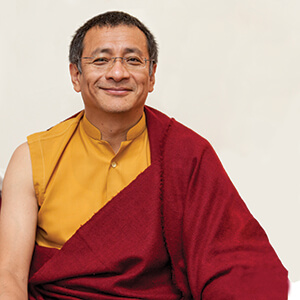
Rebel Buddha: A Guide to a Revolution of Mind
There’s a rebel within you. It’s the part of you that already knows how to break free of fear and unhappiness. This rebel is the voice of your own awakened mind. It’s your rebel buddha—the sharp, clear intelligence that resists the status quo. It wakes you up from the sleepy acceptance of your day-to-day reality and shows you the power of your enlightened nature. It’s the vibrant, insightful energy that compels you to seek the truth. READ MORE
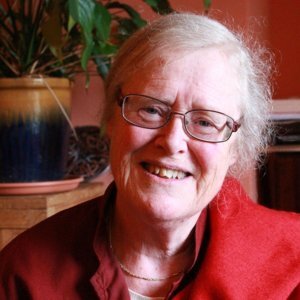
The Guru Principle: A Guide to the Teacher-Student Relationship in Buddhism
Based on over fifty years of personal experience as both a student and a teacher, Lama Shenpen Hookham writes candidly of the opportunities and challenges facing modern Dharma students who wish to study with a teacher. Traditional texts often do not reflect how the student-teacher relationship really works in practice, which leaves many pressing questions in communities taking root in the West. With honesty and clarity, Lama Shenpen discusses the roles of the teacher, practices related to the guru, and commonly asked questions she receives as a teacher. This handbook is the first of its kind, breaking down in a pragmatic and relatable way everything one needs to know to enter a student-teacher relationship with open eyes and an open heart.
Karl Brunnhölzl
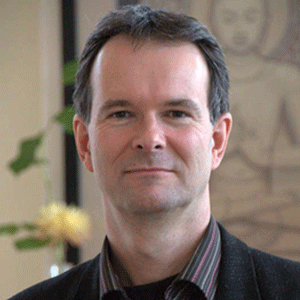
The Center of the Sunlit Sky:Madhyamaka in the Kagyu Tradition
Madhyamaka is a potent and universally accessible means of calming our suffering and awakening to our innate wisdom. The Center of the Sunlit Sky artfully rescues this brilliant teaching from its unwarranted reputation for intellectual opacity and reinstates it as a supremely practical tool kit for everyday living. The aim of this book is to take Madhyamaka out of the purely intellectual corner into which it unjustly gets boxed. It is an attempt to show how Madhayamaka actually addresses and works with all of our experiences in life. READ MORE
Learn more about Karl Brunnhölzl's here: The Works Of Karl Brunnhölzl: A Guide For Readers
Elizabeth M. Callahan
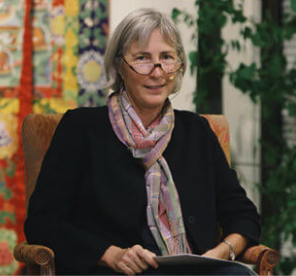
Marpa Kagyu, Methods of Liberation Part 1 from The Treasury of Precious Instructions
By Jamgon Kongtrul Lodro Taye
Translated by Elizabeth M. Callahan
The seventh volume of the series, Marpa Kagyu, is the first of four volumes that present a selection of core instructions from the Marpa Kagyu lineage of Tibetan Buddhism. This lineage is named for the eleventh-century Tibetan Marpa Chokyi Lodrö of Lhodrak who traveled to India to study the sutras and tantras with many scholar-siddhas, the foremost being Naropa and Maitripa. The first part of this volume contains source texts on mahamudra and the six dharmas by such famous masters as Saraha and Tilopa. The second part begins with a collection of sadhanas and abhisekas related to the Root Cakrasamvara Aural Transmissions, which are the means for maturing, or empowering, students. It is followed by the liberating instructions, first from the Rechung Aural Transmission. This section on instructions continues in the following three Marpa Kagyu volumes. Also included are lineage charts and detailed notes by translator Elizabeth M. Callahan.
Learn more about this series here: A Guide to the Treasury of Precious Instructions
Related Books from the Kagyu Tradition of Tibetan Buddhism
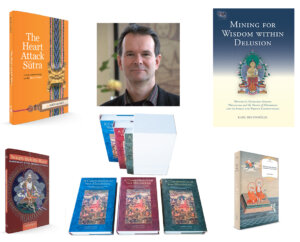
The Works of Karl Brunnhölzl: A Guide for Readers
The Works of Karl Brunnhölzl: A Guide for Readers
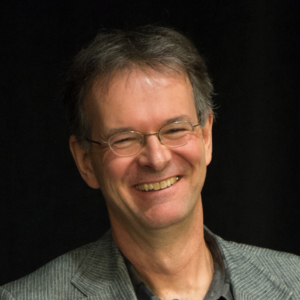
This guide for readers is dedicated to the works of author, translator, and teacher, Karl Brunnhölzl.
Originally trained as a physician, Karl Brunnhölzl later studied Tibetan language and Buddhist philosophy at the Marpa Institute for Translators and later the Nitartha Institute. Since 1989 he has been a translator and interpreter from Tibetan and English. He is presently involved with the Nitartha Institute as a teacher and translator.
Karl is well known among the Tibetan Buddhist community for his translations of some of the most widely known texts including works by Nagarjuna, Rangjung Dorje, as well as Five Maitreya Texts. Below you'll find an introduction to the selection of works found here at Shambhala Publications.
Texts and Commentary on the Prajñāpāramitā "Perfection of Wisdom" Sutras
The Prajñāpāramitā or "the Perfection of Wisdom" sutras are a collection of Mahāyana Buddhist scripture geared toward realizing the genuine nature of reality. The earliest texts that are included in the collection of Prajñāpāramitā sutras are believed to be from the 1st century BCE. Historically there have been a range of interpretations and schools of thought that derived from the Prajñāpāramitā sutras in India, most notably Madhyamaka and Yogācara, two distinct schools of thought stemming from Nāgārjuna and Asanga, respectively. Additional schools of thought have branched out from Madhyamaka and Yogācara, making their way to different regions of Asia including Japan, Tibet, China, and Korea.
In this reader guide we'll focus on the expansion of these two schools as they were explored in India and Tibet. As a Tibetan translator, interpreter, and practitioner in the Kagyu tradition, Karl Brunnhölzl offers of plethora of knowledge and experience enabling him to translate these complex and often dense philosophical texts from both the Madhyamaka and Yogācara tradition of Buddhism.
Perfection of Wisdom & the Five Maitreya Texts
According to the tradition, the Five Maitreya Texts were presented to Asanga by the bodhisattva Maitreya. These treatise include
1) The Ornament of Clear Realization (Abhisamayālaṃkāra)
2) The Ornament of the Mahayana Sutras (Māhayānasūtrālaṃkāra)
3) Distinguishing the Middle from the Extremes (Madhyāntavibhāga)
4) Distinguishing Phenomena from their Intrinsic Nature (Dharma-dharmatā-vibhāga)
5) The Sublime Continuum (Uttaratantra Śāstra)
Of the above treatise, Karl Brunnhölzl translated The Ornament of Clear Realization along with commentary from different schools of Tibetan Buddhism published as a trilogy (see below). Along the same vein, Brunnhölzl Compendium of Mahayana presents virtually everything anybody might want to know about the Yogācāra School of Mahāyāna Buddhism.
Abhisamayalamkara: The Ornament of Clear Realization
The Abhisamayalamkara summarizes all the topics in the vast body of the prajñaparamita sutras. Resembling a zip-file, it comes to life only through its Indian and Tibetan commentaries. Together, these texts not only discuss the "hidden meaning" of the prajñaparamita sutras—the paths and bhumis of sravakas, pratyekabuddhas, and bodhisattvas—but also serve as contemplative manuals for the explicit topic of these sutras—emptiness—and how it is to be understood on the progressive levels of realization of bodhisattvas. Thus these texts describe what happens in the mind of a bodhisattva who meditates on emptiness, making it a living experience from the beginner's stage up through buddhahood.
Groundless Paths
The Prajnaparamita Sutras, The Ornament of Clear Realization, and Its Commentaries in the Tibetan Nyingma Tradition
Translated by Karl Brunnhölzl
Groundless Paths contains the first in-depth study of the Abhisamayalamkara (the text studied most extensively in higher Tibetan Buddhist education) and its commentaries from the perspective of the Nyingma School of Tibetan Buddhism. This study consists mainly of translations of Maitreya's famous text and two commentaries on it by Patrul Rinpoche. These are supplemented by three short texts on the paths and bhumis by the same author, as well as extensive excerpts from commentaries by six other Nyingma masters, including Mipham Rinpoche. Thus this book helps close a long-standing gap in the modern scholarship on the prajñaparamita sutras and the literature on paths and bhumis in mahayana Buddhism.
Gone Beyond, Vol. 1 & Vol. 2
The Prajnaparamita Sutras, The Ornament of Clear Realization, and Its Commentaries in the Tibetan Kagyu Tradition
Translated by Karl Brunnhölzl
Gone Beyond contains the first in-depth study of the Abhisamayalamkara (the text studied most extensively in higher Tibetan Buddhist education) and its commentaries in the Kagyu School. This study (in two volumes) includes translations of Maitreya's famous text and its commentary by the Fifth Shamarpa Goncho Yenla (the first translation ever of a complete commentary on the Abhisamayalamkara into English), which are supplemented by extensive excerpts from the commentaries by the Third, Seventh, and Eighth Karmapas and others. Thus it closes a long-standing gap in the modern scholarship on the Prajnaparamita Sutras and the literature on paths and bhumis in mahayana Buddhism.
The first volume presents an English translation of the first three chapters of the Abhisamayalamkara and its commentary by the Fifth Shamarpa. The second volume presents an English translation of the final five chapters and its commentary by the Fifth Shamarpa.
In the video below listen to Karl Brunnhölzl discuss the trilogy on the Abhisamayalamkara: Groundless Paths and Gone Beyond Vol. 1 & 2.
Maitreya's Distinction between Phenomena and the Nature of Phenomena
Maitreya's Distinction between Phenomena and the Nature of Phenomena or Dharma-dharmatā-vibhaṅga is one of 13 core texts taught as part of monastic curriculum. The essential point of the text is, as the title entails, help a person distinguish between the illusory pheonemena of samsara and the ultimate reality, the nature of one's mind.
Mining for Wisdom within Delusion
Maitreya's Distinction between Phenomena and the Nature of Phenomena and Its Indian and Tibetan Commentaries
Translated by Karl Brunnhölzl
Maitreya’s Distinction between Phenomena and the Nature of Phenomena distinguishes the illusory phenomenal world of saṃsāra produced by the confused dualistic mind from the ultimate reality that is mind’s true nature. The transition from the one to the other is the process of “mining for wisdom within delusion.” Maitreya’s text calls this “the fundamental change,” which refers to the vanishing of delusive appearances through practicing the path, thus revealing the underlying changeless nature of these appearances. In this context, the main part of the text consists of the most detailed explanation of nonconceptual wisdom—the primary driving force of the path as well as its ultimate result—in Buddhist literature.
The Uttaratantra Śāstra "The Sublime Continuum"
The Uttaratantrashastra also called the Ratnagotravibhāga is another one of the 13 core texts studied in monastic shedras. In short, it is a commentary on the third turning of the wheel and focuses on the essential Buddhanature of all sentient beings.
When the Clouds Part
The Uttaratantra and Its Meditative Tradition as a Bridge between Sutra and Tantra
Translated by Karl Brunnhölzl
“Buddha nature” (tathāgatagarbha) is the innate potential in all living beings to become a fully awakened buddha. This book discusses a wide range of topics connected with the notion of buddha nature as presented in Indo-Tibetan Buddhism and includes an overview of the sūtra sources of the tathāgatagarbha teachings and the different ways of explaining the meaning of this term. It includes new translations of the Maitreya treatise Mahāyānottaratantra (Ratnagotravibhāga), the primary Indian text on the subject, its Indian commentaries, and two (hitherto untranslated) commentaries from the Tibetan Kagyü tradition. Most important, the translator’s introduction investigates in detail the meditative tradition of using the Mahāyānottaratantra as a basis for Mahāmudrā instructions and the Shentong approach. This is supplemented by translations of a number of short Tibetan meditation manuals from the Kadampa, Kagyü, and Jonang schools that use the Mahāyānottaratantra as a work to contemplate and realize one’s own buddha nature.
Additional Resources on the Five Maitreya Texts
The Mahāyānasaṃgraha "A Compendium of the Mahayana"
The Mahāyānasaṃgraha, published here with its Indian and Tibetan commentaries in three volumes, presents virtually everything anybody might want to know about the Yogācāra School of Mahāyāna Buddhism. It discusses in detail the nature and operation of the eight kinds of consciousness, the often-misunderstood notion of “mind only” (cittamātra), dependent origination, the cultivation of the path and its fruition in terms of the four wisdoms, and the three bodies (kāyas) of a buddha.
A Compendium of the Mahayana
Asanga's Mahayanasamgraha and Its Indian and Tibetan Commentaries
Translated by Karl Brunnhölzl
Volume 1 presents the translation of the Mahāyānasaṃgraha along with a commentary by Vasubandhu. The introduction gives an overview of the text and its Indian and Tibetan commentaries, and explains in detail two crucial elements of the Yogācāra view: the ālaya-consciousness and the afflicted mind (klistamanas).
Volume 2 presents translations of the commentary by Asvabhāva and an anonymous Indian commentary on the first chapter of the text. These translations are supplemented in the endnotes by excerpts from Tibetan commentaries and related passages in other Indian and Chinese Yogācāra works.
Volume 3 includes appendices with excerpts from other Indian and Chinese Yogācāra texts and supplementary materials on major Yogācāra topics in the Mahāyānasaṃgraha.
Perfection of Wisdom & Madhyamaka
Prajñāpāramitāhṛdaya "The Heart Sutra"
The Heart Sutra is a classic distillation of the Prajñāpāramitā Sutras, known for the famously stated "Form is emptiness, emptiness is form. Form is no other than emptiness, emptiness is no other than form"—a notable quotation in other Madhyamaka sutras and commentary. Often thought of as radical by some Buddhist thinkers, the Heart Sutra, along with the entire collection of Prajñāpāramitā Sutras pushes the barrier beyond conceptual thought through the doctrine of the two truths (relative and ultimate) pointing to the empty nature of outer and inner phenomena.
Brunnhölzl plays on this radical view of reality with the title of his commentary, The Heart Attack Sutra. To learn more about his choice of title check out the video below.
The Heart Attack Sutra
A New Commentary on the Heart Sutra
by Karl Brunnhölzl
The radical message of the Heart Sūtra, one of Buddhism's most famous texts, is a sweeping attack on everything we hold most dear: our troubles, the world as we know it, even the teachings of the Buddha himself. Several of the Buddha's followers are said to have suffered heart attacks and died when they first heard its assertion of the basic groundlessness of our existence—hence the title of this book. Overcoming fear, the Buddha teaches, is not to be accomplished by shutting down or building walls around oneself, but instead by opening up to understand the illusory nature of everything we fear—including ourselves. In this book of teachings, Karl Brunnhölzl guides practitioners through this 'crazy' sutra to the wisdom and compassion that lie at its core.
Madhyamaka in the Kagyu Tradition
While Brunnhölzl's above works present commentaries from a mix of Kagyu and Nyingma voices, the following works focus specifically on the Kagyu orientation to Madhyamaka.
The Center of the Sunlit Sky
Madhyamaka in the Kagyu Tradition
by Karl Brunnhölzl
Madhyamaka is a potent and universally accessible means of calming our suffering and awakening to our innate wisdom. The Center of the Sunlit Sky artfully rescues this brilliant teaching from its unwarranted reputation for intellectual opacity and reinstates it as a supremely practical tool kit for everyday living. The aim of this book is to take Madhyamaka out of the purely intellectual corner into which it unjustly gets boxed. It is an attempt to show how Madhayamaka actually addresses and works with all of our experiences in life.
The book follows the original Indian sources as well as the standard commentaries on Madhyamaka in the Kagyu School of Tibetan Buddhism. At the same time, these materials are adapted for a contemporary audience, combining the familiar sharpness of Madhyamaka reasonings (launching a massive assault on our cherished belief systems) with exploring the practical relevance of the Madhyamaka way of mind training.
Commentaries from the Third Karmapa, Rangjung Dorje
While the above books make a clearer distinction between the philosophcal traditions of Yogacara and Madhyamaka, Brunnhölzl also has two translations of works by the great Kagyu master Rangjung Dorje, the Third Karmapa. Indicative of the deeper levels of Kagyu philosophy and practice, the union of Yogacara and Madhyamaka represent some of the more subtle teachings of Mahayana Buddhism.
In Praise of Dharmadhatu
Nagarjuna and Rangjung Dorje on Buddha Nature
by Karl Brunnhölzl
Nāgārjuna's works sit at the heart of Mahāyāna Buddhist thought and practice, but he was renowned in Asia not only for his Madhyamaka work, but also his poetic collection of praises, most famously In Praise of Dharmadhatu. This book explores the scope, contents, and significance of Nāgārjuna’s scriptural legacy in India and Tibet, focusing primarily on this seminal work. The translation of Nāgārjuna’s hymn to buddha nature—here called dharmadhatu—shows how buddha nature is temporarily obscured in the experience of ordinary sentient beings, gradually uncovered through the path of bodhisattvas, and finally revealed in full bloom as buddhahood. Included is a translation of the text’s earliest and most extensive commentary by the Third Karmapa, Rangjung Dorje (1284–1339), supplemented by relevant excerpts from all other available commentaries.
Luminous Heart
Essential Writings of Rangjung Dorje, the Third Karmapa
by Karl Brunnhölzl
This extraordinary collection of writings on buddha nature by the Third Karmapa Rangjung Dorje (1284–1339) focuses on the transition from ordinary deluded consciousness to enlightened wisdom, the characteristics of buddhahood, and a buddha’s enlightened activity. The Third Karmapa’s unique and balanced view synthesizes Yogacara Madhyamaka and the classical teachings on buddha nature. Included are commentaries by Jamgön Kongtrul Lodrö Tayé that supplement the view of the Third Karmapa on two fundamental treatises on buddha nature, emphasizing the luminous empty mind of buddha nature as presented by the great Indian masters Maitreya and Asaṅga. For those practicing the sutrayāna and the vajrayāna in the Kagyü tradition, what these texts describe can be transformed into living experience.
Poetry, Song, and "Pith Instructions"
The last book for this reader's guide is a collection of teachings, songs of realization, and advice for practitioners on the path from both Indian and Tibetan masters.
Straight from the Heart
Buddhist Pith Instructions
by Karl Brunnhölzl
Straight from the Heart brings together an inspiring collection of Buddhist teachings, songs of realization, meditation instructions, and enlightened poetry—all chosen for their power to speak directly to the student. Drawn from Indian Mahayana and Vajrayana Buddhism as well as from all four schools of Tibetan Buddhism, some will impress with their beautiful poetry and powerful imagery, others with their profound power of instruction. Still others share personal advice for life that seems to come directly from the mouth of the author, and some serve as immediate and profound practice instructions. Several are just delightfully unconventional, even outrageous, letting in fresh air on petrified views or musty traditions. Most of them are simply unknown precious gems, which deserve a wider audience. Each of the works is preceded by a brief introduction and a short biography of its author. Many of these are legendary accounts of supernatural feats, edifying examples for students on the same spiritual path meant to expand their limited outlook with “mind-blowing” stories. Miraculous deeds, magnificent songs, and pithy instructions distinguish this collection assembled by the Buddhist scholar and translator Karl Brunnhölzl, whose years of work among dharma texts and his skill as a translator yield a rich mine of teachings all chosen for their ability to speak directly to the heart.

